Istanbul is a city where your commute might take you past a 1,500-year-old basilica cistern, a bustling spice market, and a ferry cutting across two continents. It’s not just a place to live—it’s a place to be absorbed. Every street has layers: Ottoman palaces beside modern art galleries, ancient alleyways opening onto neon-lit rooftops, quiet tea gardens hidden a few steps from the roar of traffic. For digital nomads, it offers a rare combination: the hum of a global hub and the texture of a living museum.
In this full guide, we’ll take you through what it’s like to work, wander, and weave yourself into Istanbul’s rhythms—and link you to our deeper guides on neighborhoods, food scenes, cultural landmarks, day trips, and the best ways to cross the Bosphorus.
Why Istanbul?
There are few cities in the world where you can finish a call in a modern coworking space, then step outside into the shadow of a Byzantine cathedral-turned-mosque. Istanbul is one of them. Straddling Europe and Asia, it’s a city of juxtapositions: traditional and avant-garde, devotional and playful, chaotic and serene.
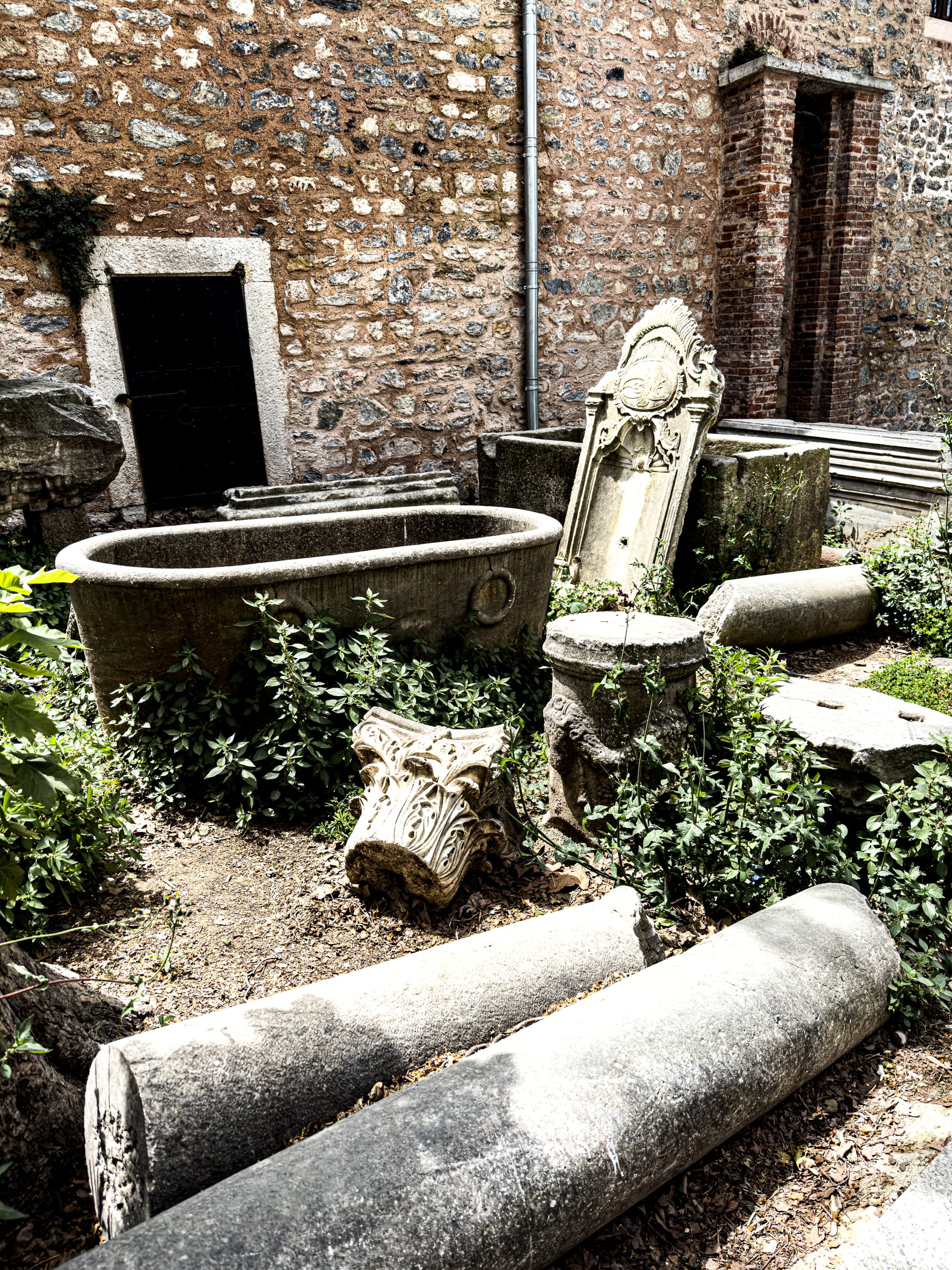
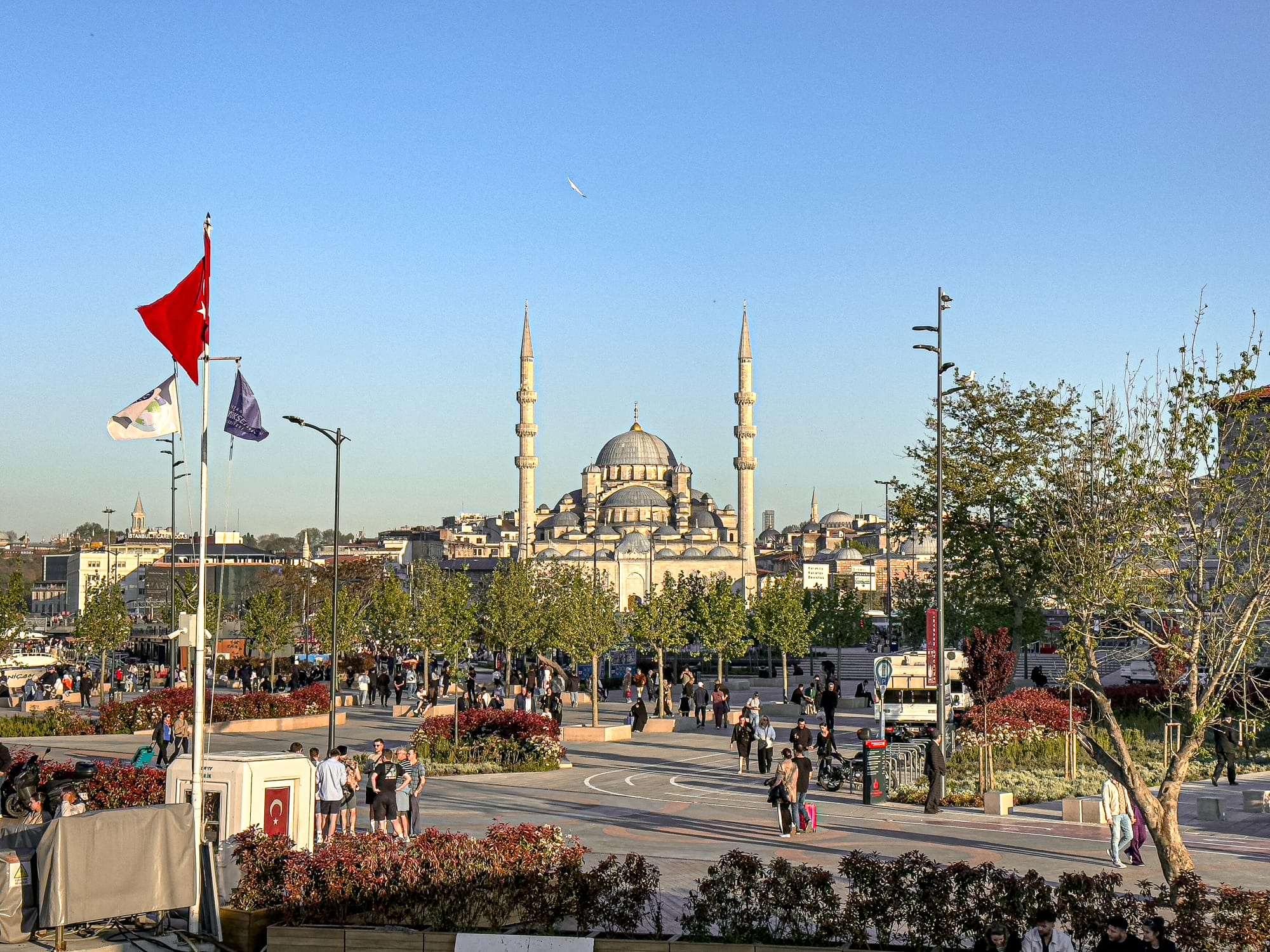
What makes Istanbul distinct from other nomad destinations isn’t just its scale or its skyline—it’s the sense of continuity. You can sip third-wave coffee in Karaköy and then stroll into a centuries-old hammam. You can work from a leafy courtyard in Kadıköy and cross the Bosphorus at sunset for dinner in Beyoğlu. Everything feels both immediate and timeless.
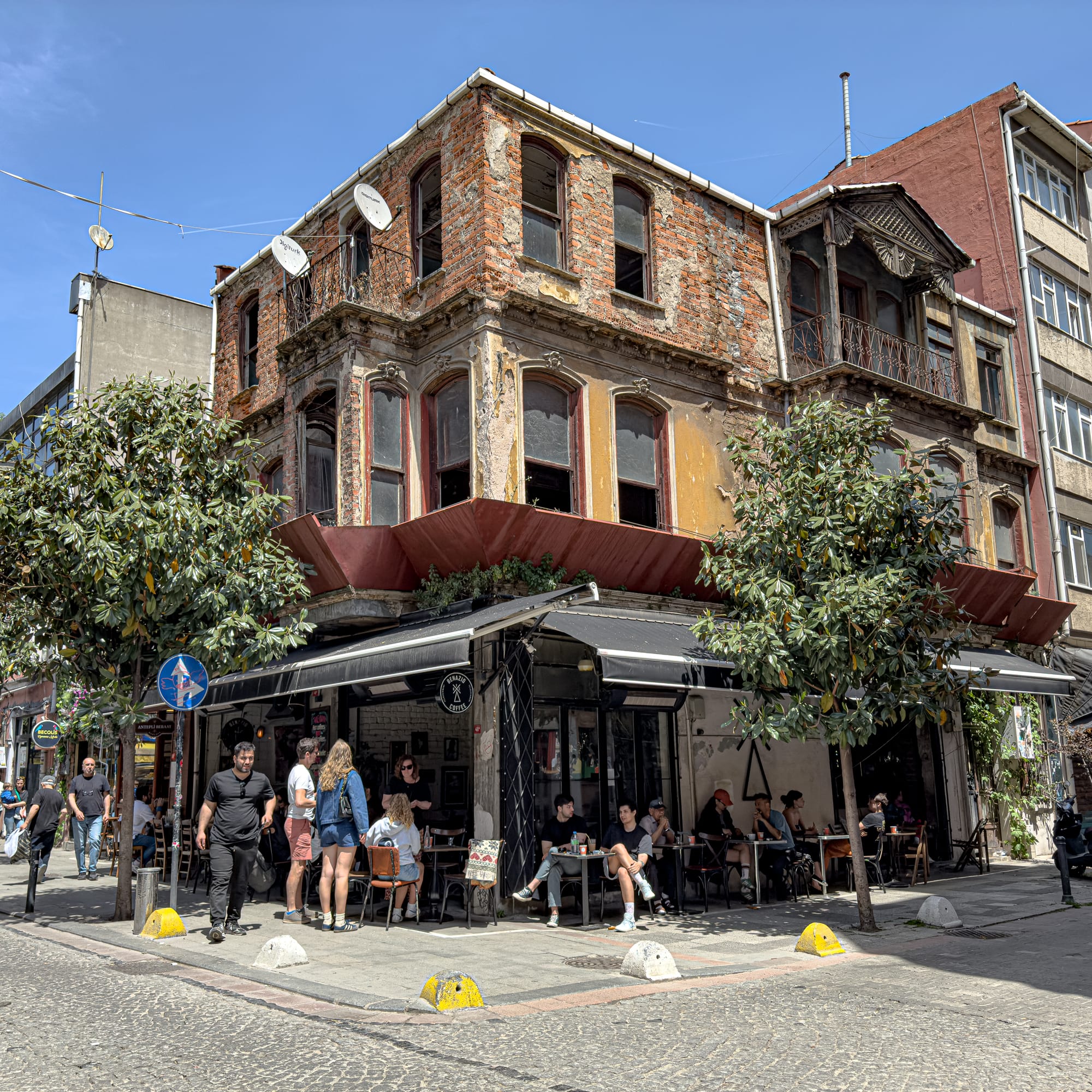
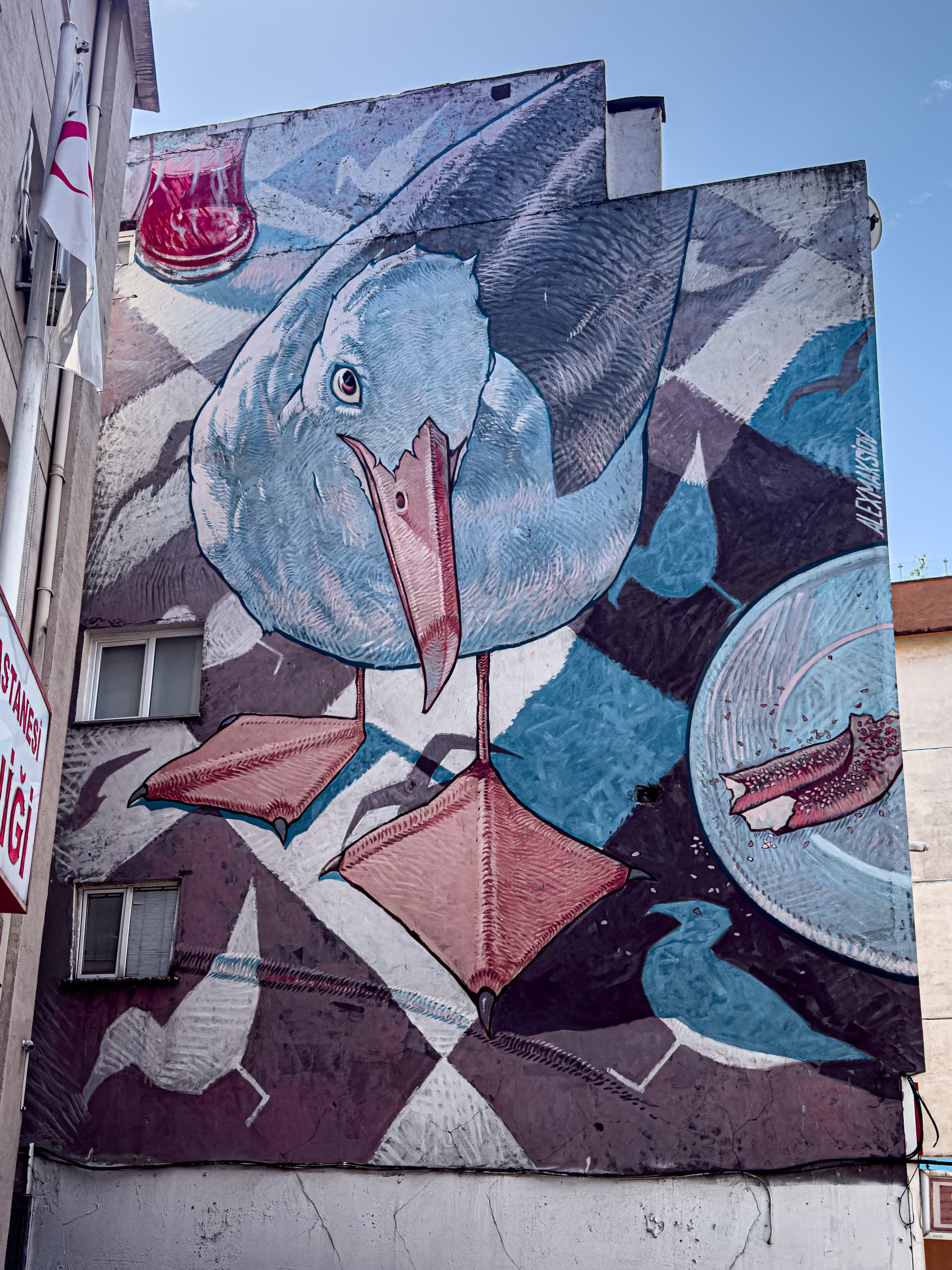
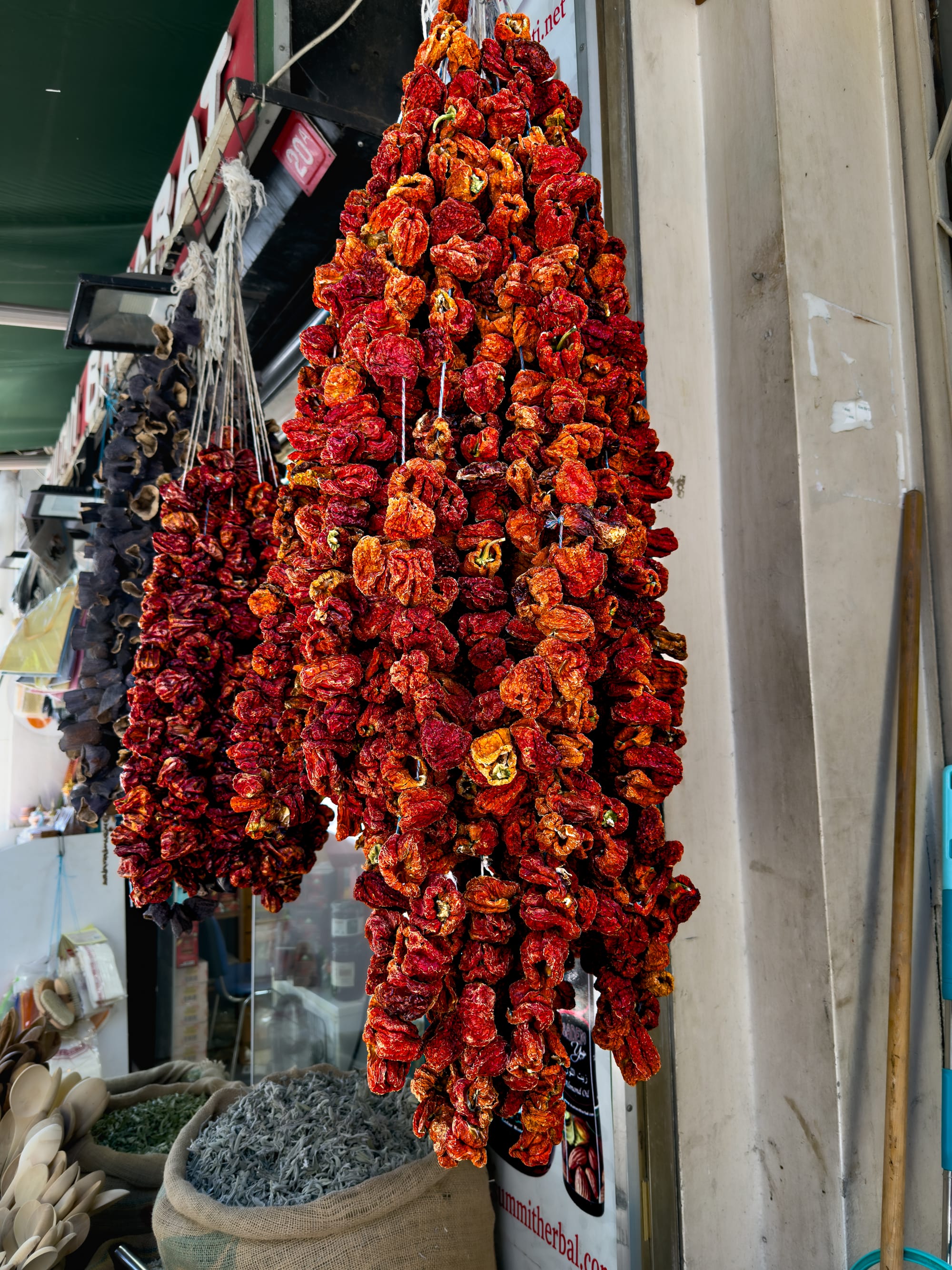
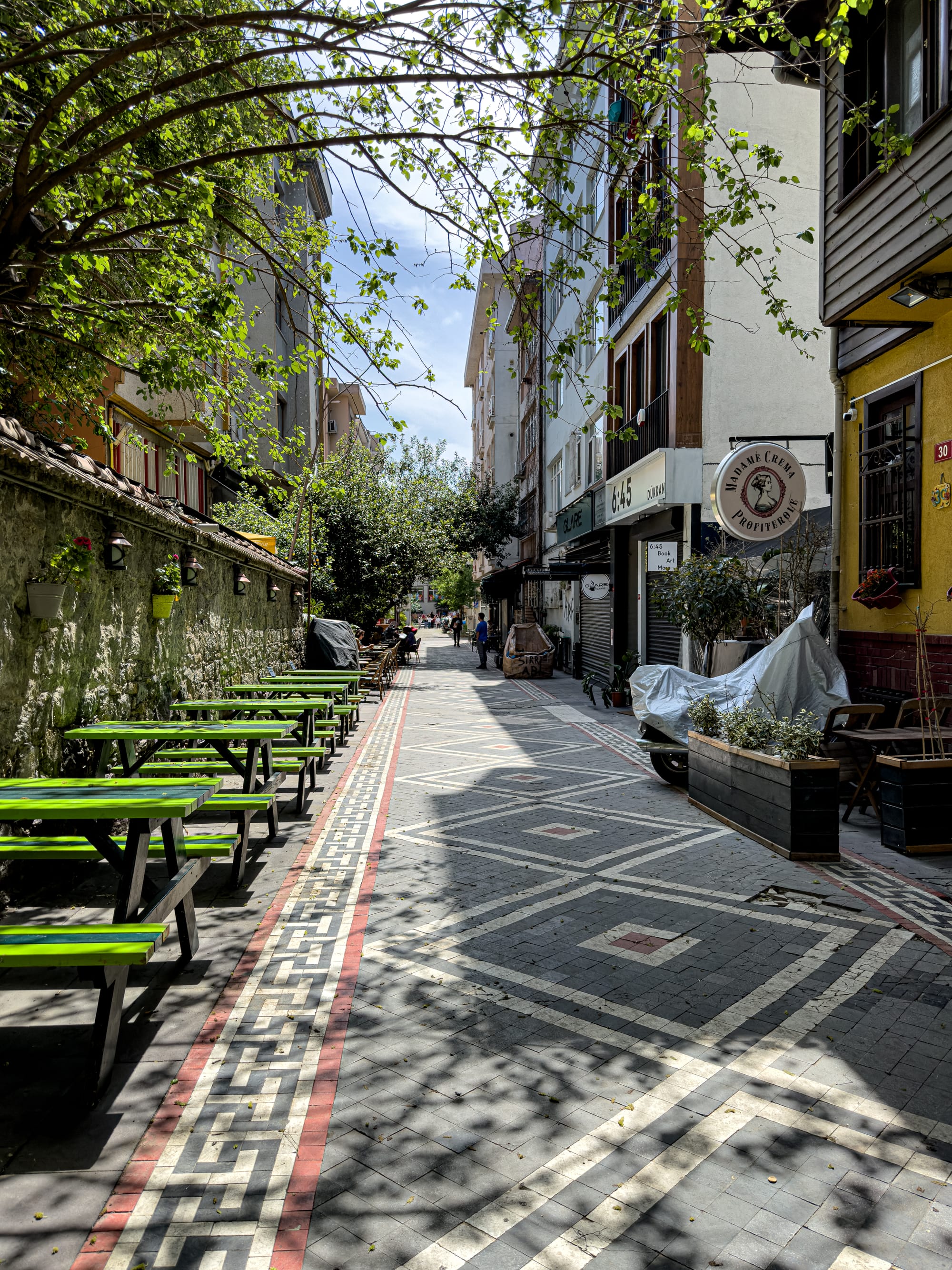
Unlike purpose-built nomad enclaves, Istanbul is a fully formed metropolis with its own pulse. You’re not entering a curated remote work bubble—you’re plugging into a vast, multilingual, ever-changing ecosystem. You’ll find the infrastructure you need—fast internet, great coffee, creative workspaces—but you’ll also find call to prayer echoing through your window, fresh simit sold from street carts, and the constant pull to look up from your laptop and step into history.
The city is the crossroads
In Istanbul, you don’t have to imagine the meeting of worlds—it’s under your feet, over your head, in the ferry’s wake.
The city doesn’t have a single center. It has many, and they pull you in different directions: the spice-scented chaos of Eminönü, the polished galleries of Karaköy, the café-lined backstreets of Moda, the quiet courtyards of Eyüp. Each one feels like it could be its own city, but they’re all stitched together by water, bridges, and the slow churn of the Bosphorus.
Even your commute can be an epic. You might cross continents before lunch, leaving an apartment in Asia to work from a coworking space in Europe. You might ride a ferry with fishermen and school kids, watching the skyline tilt between minarets and modern towers. You might duck into a 500-year-old hammam after work, the same way someone might elsewhere stop for a pint.
Istanbul’s scale is vast, but the connections are intimate. You start to learn when the light hits the Galata Tower just right from the ferry deck. You have a favorite simit seller who knows your order. You figure out which side of the tram has the better view of the Golden Horn.
The constant crossing—of water, of history, of cultures—changes how you move through your days. It’s not a place you “check off” with a single itinerary. It’s a place you orbit, loop through, and layer over time. And somewhere between all those crossings, the city starts to feel less like a backdrop and more like an active participant in your work and life.
When to go
The best months to visit Istanbul are late April through early June, with May being our personal favorite. The city’s parks—like Gülhane and Emirgan—are in full bloom, the weather is pleasantly warm without the summer humidity, and outdoor cafés and Bosphorus ferries feel just right. You can wander comfortably through the Old City, cross continents by ferry, and still have the light jacket weather that makes long days out easy.
July and August are Istanbul’s peak summer—hot, busy, and full of life. Expect higher humidity, more cruise ship crowds in the historic core, and longer lines at major sights like Hagia Sophia or Topkapı Palace. That said, it’s also the season for late-night ferry rides, rooftop dinners, and the city’s open-air festivals. If you can plan your sightseeing early in the day and work indoors during the hottest hours, it can be a vibrant time to be here.
September is a fantastic under-the-radar choice. The heat eases, the sea breeze sharpens, and the post-summer lull makes even popular spots a little calmer. You can still enjoy the Princes’ Islands for swimming or cycling, and the light over the Bosphorus starts to turn golden earlier in the evening.
October brings crisp air, clear skies, and fewer visitors—perfect for walking-heavy days in neighborhoods like Balat, Kadıköy, or Üsküdar. It’s also a great month for photography, with softer sunsets and a calmer pace along the waterfront.
November through March is Istanbul’s true off-season. The city is cooler and more prone to rain, but major sights remain open, ferries still run, and the city’s indoor life—museums, hammams, coffeehouses—comes into its own. This can be a richly atmospheric time for slower travel and deep work, though daylight hours are shorter and it’s wise to pack for damp weather.
Our advice on the best time to be in Istanbul
If you’re coming to work remotely and explore on weekends, aim for April–June or mid-September to late October. You’ll get mild temperatures, long days, and a calmer rhythm in both coworking spaces and tourist districts.
If you’re here for the buzz—nightlife, festivals, and packed waterfronts—July and August deliver energy in full, though you’ll need to work around heat and crowds.
If you’re into photography, street wandering, or long ferry rides, October and spring offer ideal light and comfortable walking weather.
If you’re looking for an off-season base with fewer tourists, November–March is your moment. You’ll trade long days for quieter streets and the warmth of Istanbul’s indoor culture.
No matter when you go, pack a light jacket and comfortable shoes. The weather can shift quickly between neighborhoods, and you’ll likely walk more than you expect.
Getting to and from Istanbul
Istanbul is one of the world’s major air hubs, served by two airports: Istanbul Airport (IST) on the European side and Sabiha Gökçen Airport (SAW) on the Asian side. Both handle international and domestic flights, but IST is the larger and busier of the two, with Turkish Airlines and many other carriers using it as a key transit point between Europe, Asia, Africa, and the Americas. It’s common to find long-haul itineraries routing through Istanbul, even if you’re just connecting onward.
If you’re arriving from elsewhere in Turkey, frequent domestic flights connect Istanbul with cities like Antalya, Izmir, Ankara, and Cappadocia’s Nevşehir and Kayseri airports. Many routes are under an hour and competitively priced. For a slower approach, Turkey’s intercity bus and train network links Istanbul with much of the country, though travel times can be long given the city’s geographic location.
From IST, it’s about 40–60 minutes to central neighborhoods by taxi or airport shuttle, depending on traffic. From SAW, expect closer to 60–90 minutes for the same journey. Public transit options—including metro connections and municipal buses—are improving, but plan for extra time if you’re arriving during peak hours.
For nomads weaving Istanbul into a regional trip, the city pairs naturally with hubs like Athens, Tbilisi, or Sofia, and with direct flights to countless European capitals.
Working remotely from Istanbul
Istanbul offers one of the most dynamic café-working cultures we’ve seen anywhere. From minimalist third-wave coffee shops in Kadıköy to atmospheric tea gardens on the European side, you’re never far from a space with good wifi, strong espresso, and an inviting corner to settle in for a few hours. Many cafés are accustomed to laptop workers, especially in younger, creative neighborhoods like Kadıköy, Karaköy, and Beyoğlu.
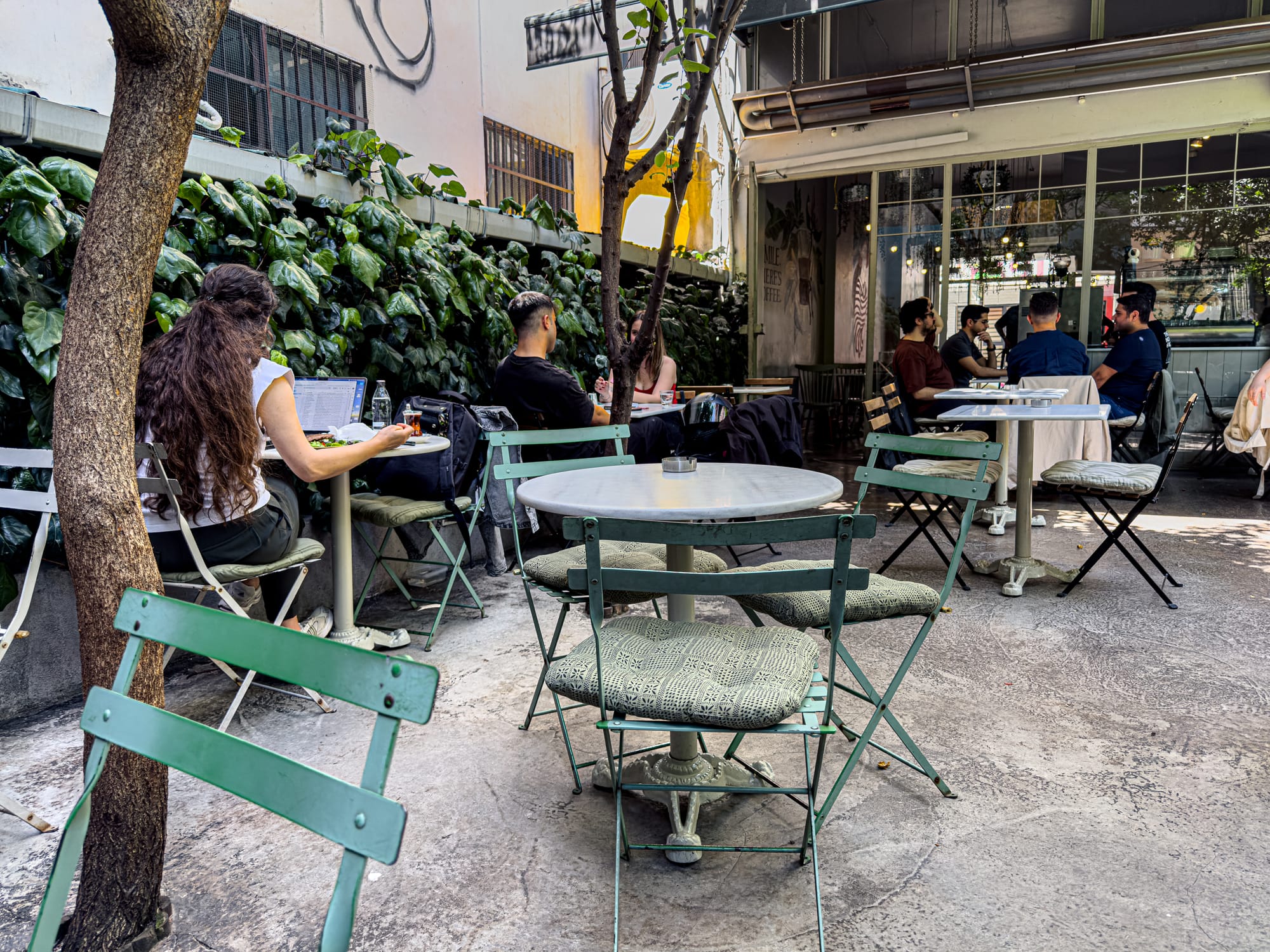
For those who prefer a more structured setup, the city has a growing number of coworking spaces catering to a mix of locals, startups, and nomads. Options range from sleek, high-rise offices with panoramic Bosphorus views to boutique, design-forward spaces in historic buildings. Some offer day passes, while others are membership-based, so it’s worth checking ahead.
Neighborhood choice can make a big difference. If you’re based in Kadıköy, you’ll have access to a huge range of vegan-friendly cafés, laid-back work spots, and the ferry for a scenic commute to the European side. Around Beyoğlu and Karaköy, you’ll find trendier coworking hubs within walking distance of art galleries, rooftop bars, and the historic Galata Tower.
Wherever you base yourself, fast internet is easy to come by, and most areas have both 4G and 5G coverage for mobile hotspots. The city’s energy can be intense, so if you’re balancing deep work with exploration, it’s worth scheduling café sessions in the quieter mornings before Istanbul’s rhythm kicks into high gear.
Digital nomad community
Istanbul’s size is both its gift and its challenge for digital nomads. With nearly 16 million people spread across two continents, the city has endless places to work and socialize—but the community itself feels more dispersed than in smaller nomad hubs. There’s no single neighborhood or coworking space where everyone naturally congregates, so it’s easy to feel lost in the sheer scale of it all.
If you’re looking to plug in quickly, Nest Digital Nomad House in Kadıköy is your best bet. This coliving attracts a steady flow of remote workers, creatives, and entrepreneurs, making it one of the few places in the city where meeting other nomads happens organically. Shared spaces and regular social activities help bridge the gap that Istanbul’s sprawl can create.
Outside of coliving, you’ll find pockets of nomad-friendly spaces—coworking studios in Beyoğlu, creative cafés in Kadıköy, and rooftop work spots in Karaköy—but they’re scattered, and the nomad crowd tends to be more transient. Many stay for a few weeks between other destinations, so the community shifts quickly.
The upside is that Istanbul draws a diverse mix of people. You’ll meet locals working remotely for Turkish startups, expats building businesses here, and fellow nomads passing through on longer overland or regional trips. The connections you make might be short-term, but they’re often rich in cultural exchange. If you’re proactive about showing up—whether that’s joining events at Nest, saying yes to café meetups, or even creating your own gatherings—you can carve out your own little network in the middle of this vast, historic city.
Istanbul's culture
Istanbul’s culture is a tapestry woven from centuries of empire, trade, migration, and everyday life. Straddling Europe and Asia, the city carries the weight of history in its mosques, palaces, and bazaars, yet hums with the energy of a place constantly reinventing itself. Here, Ottoman grandeur sits beside modern street art, and the scent of freshly baked simit drifts past shop windows filled with the latest fashions.
Daily rituals anchor the city’s rhythm. Tea—served in tulip-shaped glasses—is a constant, whether sipped at a tiny corner stand, during a ferry ride across the Bosphorus, or while bargaining at the market. Ferries themselves are more than transport—they’re social spaces, offering a pause between continents. The call to prayer ripples over the skyline five times a day, threading together neighborhoods as diverse as the quiet, residential backstreets of Üsküdar and the bustling avenues of Beyoğlu.
Markets are central to life here. From the sprawling Grand Bazaar to neighborhood street markets like Kadıköy’s Tuesday and Friday bazaars, people shop not just for produce and household goods, but for connection—a chance to talk with familiar vendors, swap recipes, and catch up on local news. In spring, tulip festivals fill the parks with color; in summer, rooftop terraces come alive with music and conversation; in autumn, locals gather along the waterfront for roasted chestnuts and tea.
Istanbul’s cultural calendar is just as layered as its history. Ramadan brings lively evening gatherings, while Republic Day is marked by parades and fireworks. International art and film festivals run alongside neighborhood street fairs. You might see a Sufi whirling ceremony one evening and a contemporary dance performance the next.
Despite its size and fast pace, Istanbul still offers moments of intimacy—a shopkeeper remembering your favorite bread, a stranger pointing you in the right direction with a smile, or a quiet moment watching the ferries from the Galata Bridge. It’s a city of contrasts: ancient and modern, grand and gritty, always in motion yet full of places to pause and simply take it in.
Psychogeographics
What does it actually feel like to live in Istanbul for a month or more? Think ferry horns at dawn, the scent of simit drifting through narrow streets, and the shimmer of the Bosphorus catching the day’s first light. This is a city where mornings might start on a rooftop terrace with the skyline spread before you—domes, minarets, and cargo ships slipping between continents—and end with tea in a back-alley café, the table sticky from a hundred conversations before yours.
Istanbul hums. It’s the hum of markets, traffic, seagulls, and the call to prayer echoing from dozens of mosques in imperfect unison. The city moves fast, but its pace is layered—one street brimming with shoppers, the next hushed and residential.
You’re never far from history here. You might work in a modern café, then step outside to pass a Byzantine cistern or an Ottoman fountain. The air carries the mix of roasted chestnuts, diesel fumes, sea salt, and brewing tea. Stray cats pad across shop counters, dogs sleep in the shade of tram stops, and ferries carve slow, steady lines between two continents.
We wrote a full piece on the texture of life here: Between continents, between timelines: digital nomad life in Istanbul.
Where to stay
Istanbul’s sheer size and variety mean that where you base yourself will shape your experience—your commute times, your neighborhood feel, your café culture, and even the kinds of people you meet. Here are our top recommended areas for digital nomads, plus hand-picked accommodation options in each.
Kadıköy
Kadıköy, on the Asian side, is vibrant, youthful, and full of independent cafés, bookshops, and markets. It’s well-connected to the European side via ferries and the metro, but many nomads find they don’t need to cross the Bosphorus daily—everything from coworking spots to great food is right here. The Yeldeğirmeni neighborhood in particular has a creative, slightly bohemian feel.
Nest Digital Nomad House: A well-located coliving in Kadıköy, offering flexible private rooms, communal work areas, and a kitchen. Perfect if you want to meet other nomads and build an instant social circle.
Remta Real Estate Apartment: Spacious 1-bedroom apartment with a kitchenette, located near the metro. Quiet enough for deep work but close to local life.
Allegro Apartments Kadıköy: Minimalist self-contained flats with kitchenettes, strong wifi, and easy access to metro and ferry lines. Ideal for independence and central convenience.
Fatih
Fatih is historic Istanbul at its most atmospheric, with the Hagia Sophia, Blue Mosque, and Grand Bazaar within easy reach. Staying here means you’ll be surrounded by Ottoman architecture and winding streets, but still close to transport connections across the city.
Viva Butik Sirkeci: A charming boutique stay with clean rooms and a sunny terrace, walking distance to the Spice Bazaar and Topkapı Palace.
La Casa Privada: Stylish 2- or 3-bedroom apartments with kitchenettes, aircon, wifi, and a terrace—great for couples or small groups seeking comfort in a historic setting.
Urban Quarters – Gülhane: Modern, well-equipped apartments under 10 minutes from major landmarks. Strong wifi and sleek interiors make it a great work-and-explore base.
Balat
Balat is one of Istanbul’s most colorful and photogenic neighborhoods, known for its pastel-painted houses, vintage shops, and slower pace. It’s less central than Kadıköy or Beyoğlu, but full of charm and local character.
Stanbul House: Cozy stay near Balat’s vintage shops, cafés, and photogenic streets. Perfect for travelers who want to soak up old Istanbul at a more relaxed pace.
Beyoğlu
Beyoğlu is lively, central, and a hub for nightlife, restaurants, and cultural events. Cihangir and Galata in particular are favorites among creatives and expats. You’ll be close to Taksim Square, Istiklal Street, and plenty of coworking-friendly cafés.
Designer Apartment in Beyoğlu: A thoughtfully styled 1-bedroom apartment near Vegan Istanbul, Cihangir cafés, and Galata Tower. Great for exploring Istanbul on foot.
The best things to do in Istanbul
Istanbul overflows with things to see and experience—but what stayed with us most weren’t just the grand monuments, but the in-between moments. Watching the city light up from a ferry deck, wandering spice-scented streets, or stumbling upon a hidden courtyard café after exploring a centuries-old bazaar. It’s a place where each turn offers a shift in texture—from Ottoman domes to modern street art, from quiet backstreets to bustling markets.
This list gathers our personal highlights—experiences we’d seek out again without hesitation. Some are iconic, others live in smaller corners of the city you might not find without looking. Many have their own full posts if you’d like more detail, photos, or tips. Our advice: resist the urge to tick off every landmark. Choose the ones that speak to you, and give Istanbul the space to surprise you.
Famed landmarks
Topkapı Palace
Ottoman opulence at the empire’s heart.
Once the seat of the Ottoman sultans for over four centuries, Topkapı Palace is a sprawling complex of courtyards, pavilions, and ornate chambers that speaks to the grandeur of an empire at its height. Walking through its gates feels like stepping into another world—one where jeweled thrones sat beneath ceilings painted in gold, and views from marble terraces stretched over the meeting point of Europe and Asia. Each section offers a glimpse into imperial life, from the ceremonial courtyards where state affairs unfolded to the private gardens where sultans and their families sought quiet retreat.
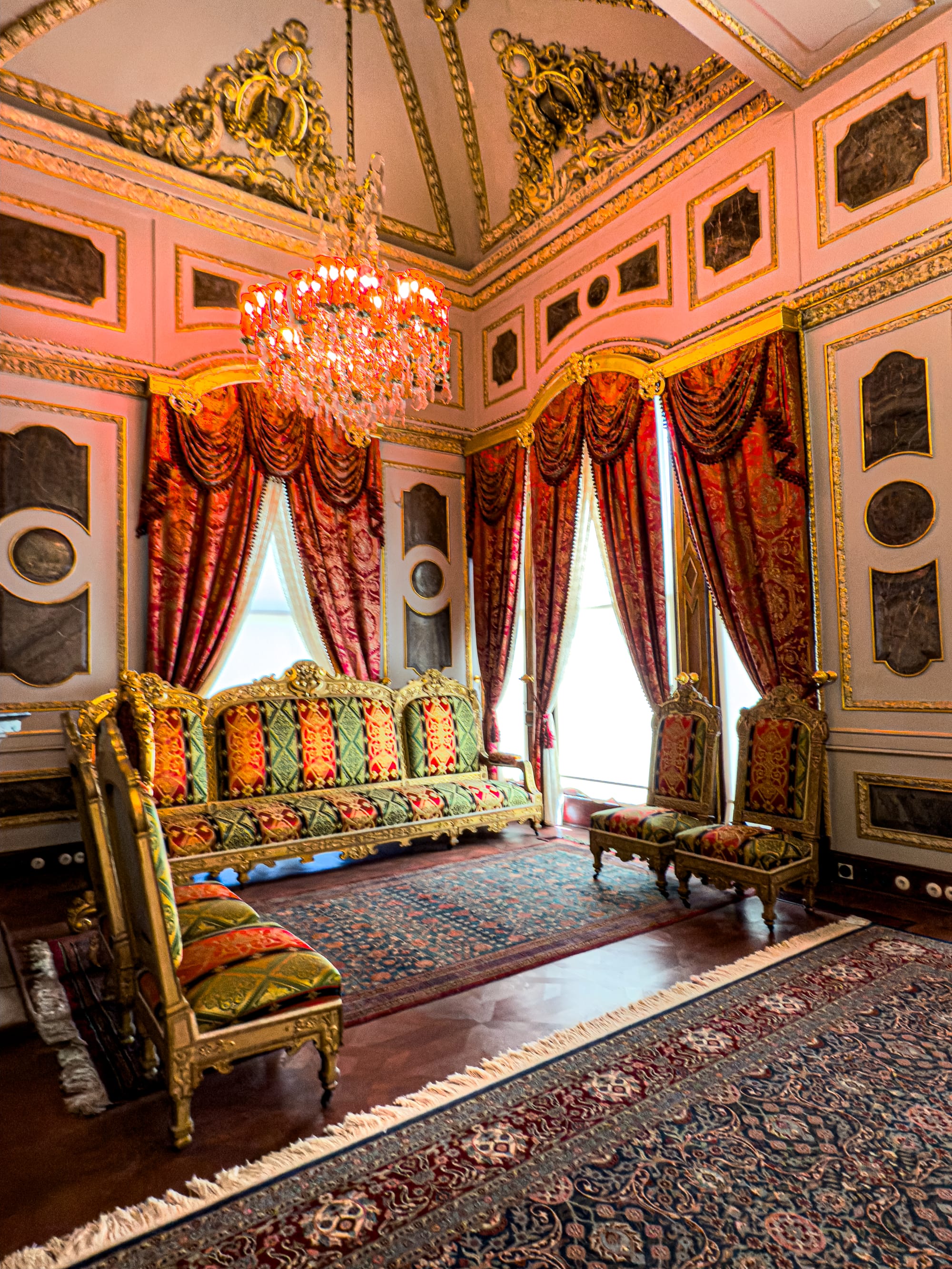
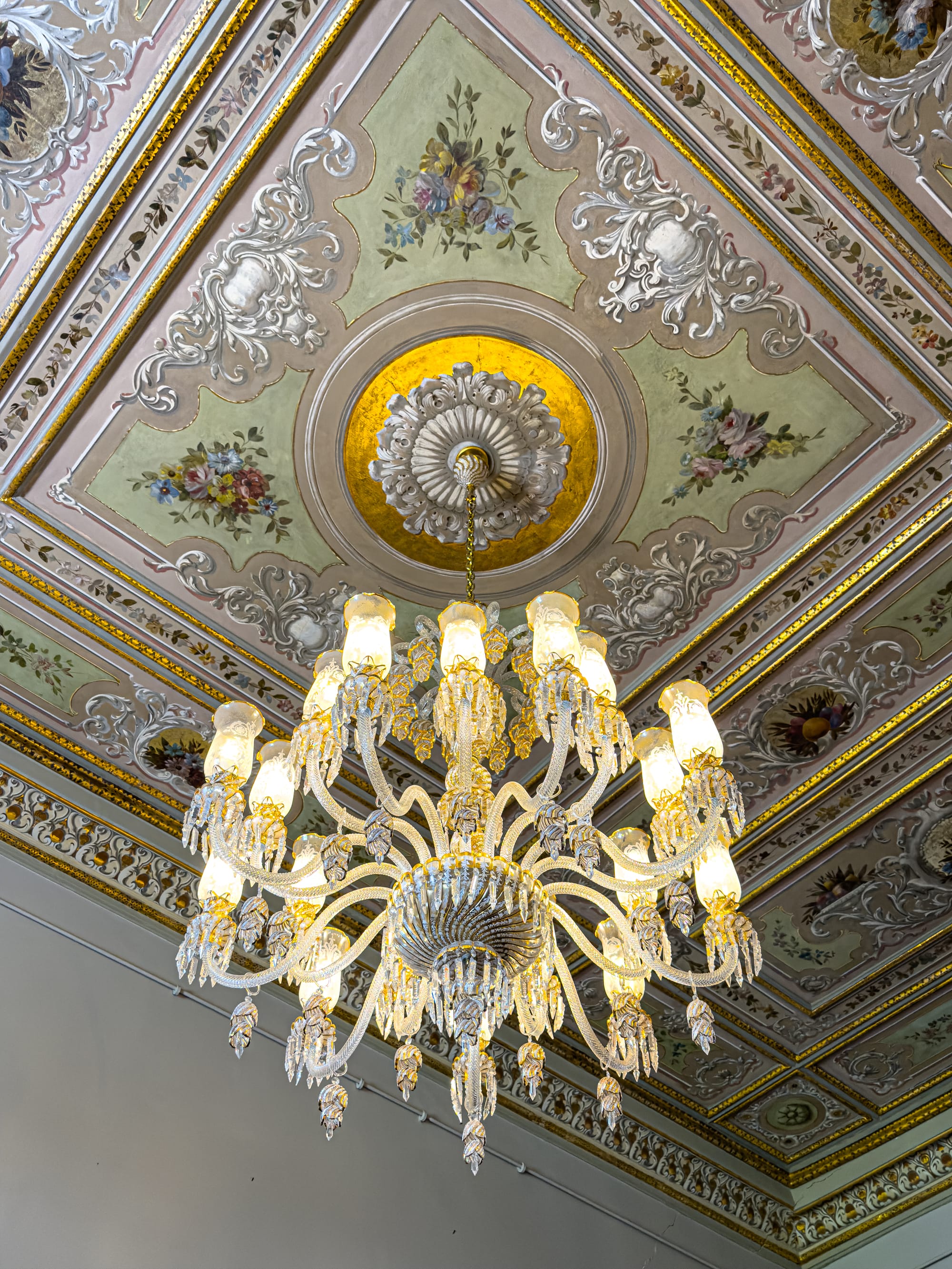
Inside, the collections are staggering: diamond-encrusted daggers, robes woven with gold thread, and manuscripts illuminated in vivid pigments. The famed Harem is a maze of tiled rooms and carved wooden screens, its design equal parts beauty and control. Beyond the walls, the palace grounds open to sweeping views over the Bosphorus, reminding you why this location was both strategic and symbolic. Even amid Istanbul’s many landmarks, Topkapı stands apart—not just for its history, but for how completely it immerses you in the rhythms, aesthetics, and ambitions of the Ottoman court.
The Basilica Cistern
An underground palace of shadows and columns.
Hidden beneath the streets of Istanbul’s historic center, the Basilica Cistern is an atmospheric masterpiece of Byzantine engineering. Built in the 6th century under Emperor Justinian I, it once supplied water to the Great Palace and later to the Topkapı Palace. Descend into its cool depths and you’ll find yourself in a vast underground chamber supported by more than 300 marble columns, their reflections shimmering in the shallow water that still flows here. The dim, amber lighting and the quiet sound of dripping water give the space an almost otherworldly quality.
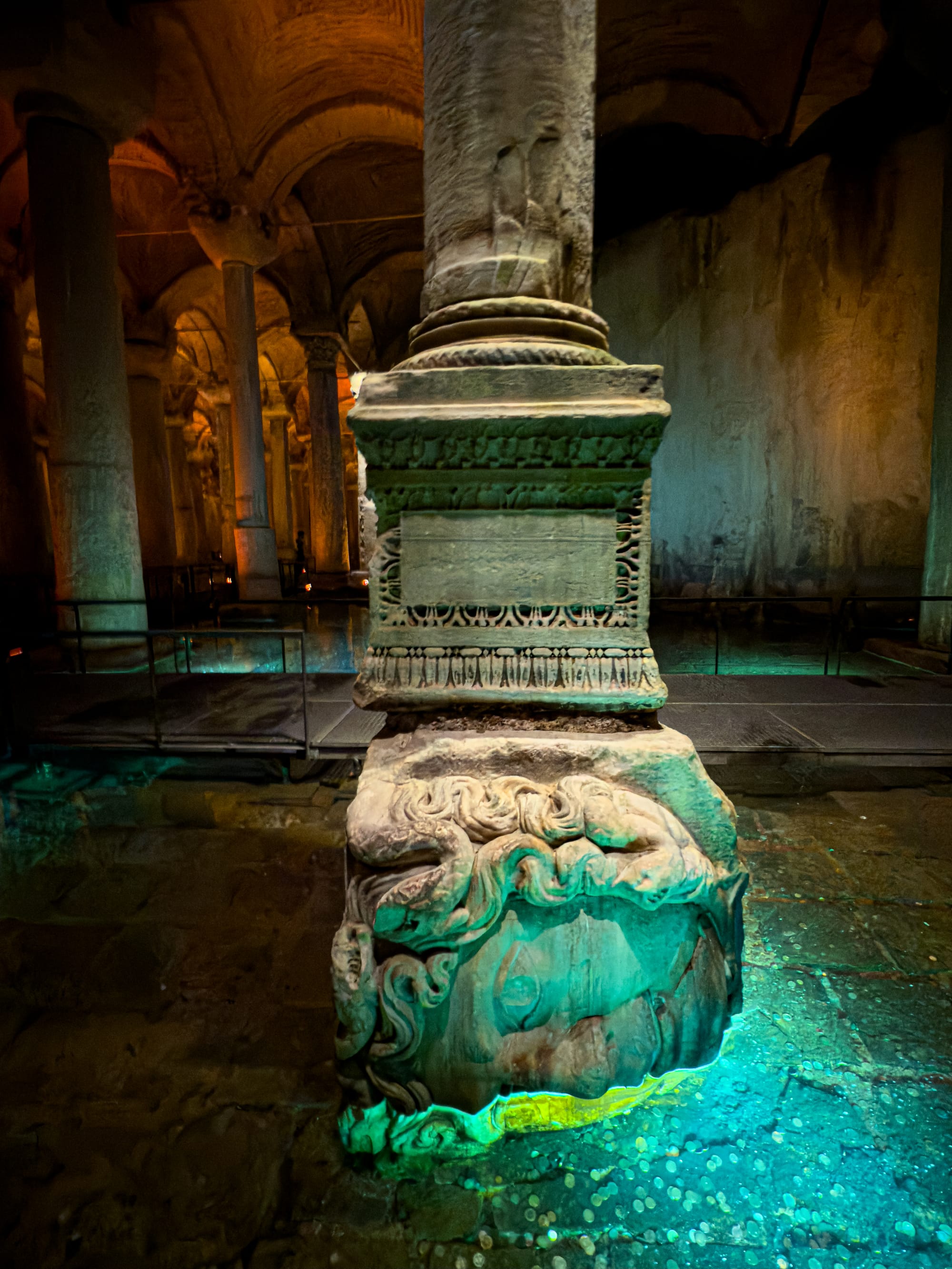
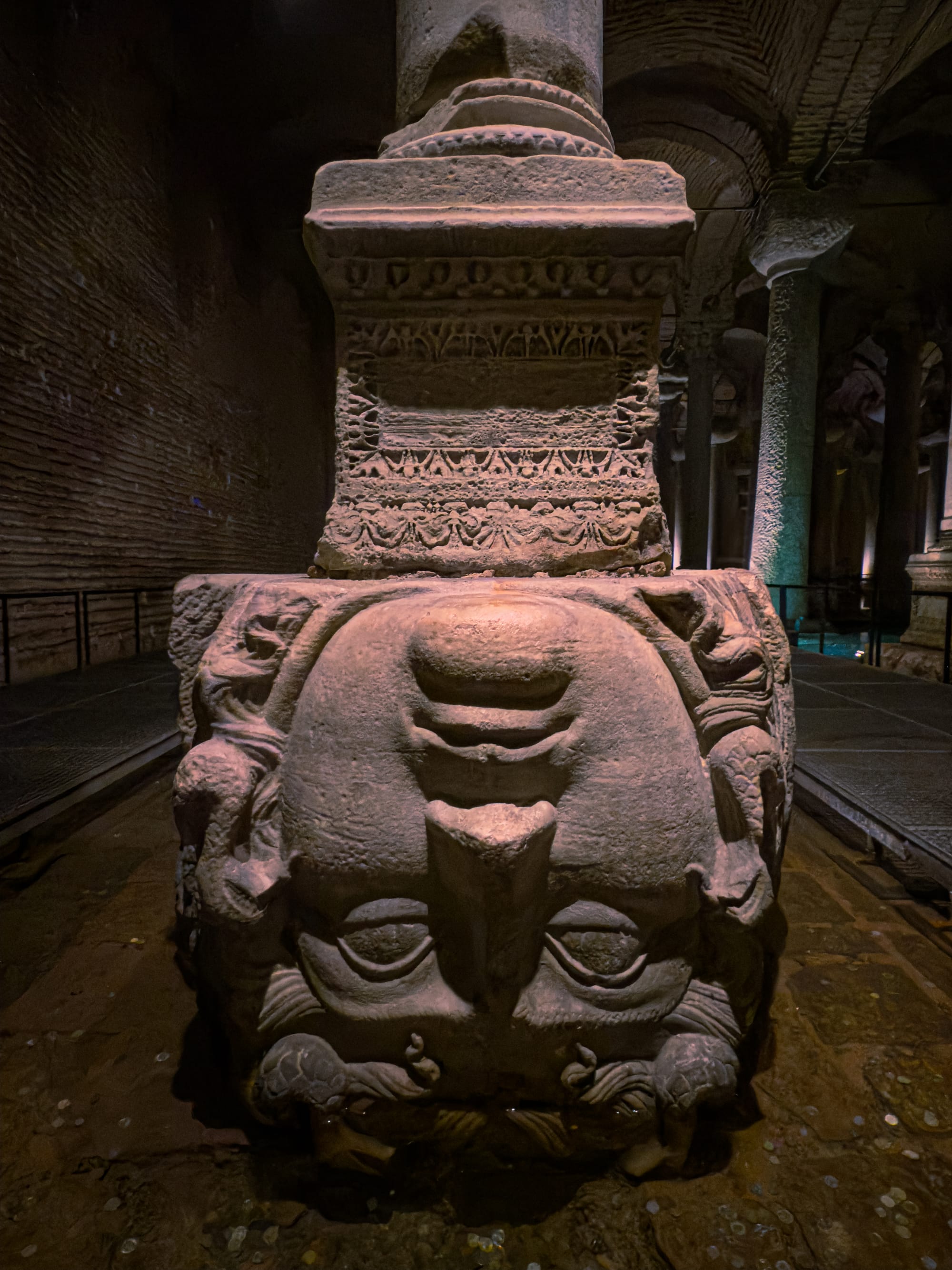
Among its most famous features are the two Medusa head column bases, whose origins and purpose are still debated—one lies sideways, the other upside-down, adding an air of mystery to the space. Each column has its own story, some repurposed from older Roman structures, their carvings and capitals worn smooth by centuries. It’s a place that rewards slow wandering: look closely and you’ll notice carved patterns, hidden corners, and the occasional art installation that plays with the Cistern’s natural acoustics and haunting beauty.
Hagia Sophia
Where empires and faiths converge.
Standing at the heart of Istanbul’s historic peninsula, Hagia Sophia is more than a building—it’s a living record of nearly 1,500 years of history. First built in 537 AD under Emperor Justinian I, it was the crown jewel of the Byzantine Empire, famed for its massive dome and innovative engineering. Later converted into an Ottoman mosque, and more recently reconverted from a museum back into a mosque, it has served as both a political and spiritual centerpiece for empires that spanned continents. Walking inside, the sheer scale is humbling: the vast dome seems to float above you, supported by towering columns and walls lined with a blend of Islamic calligraphy and Byzantine mosaics.
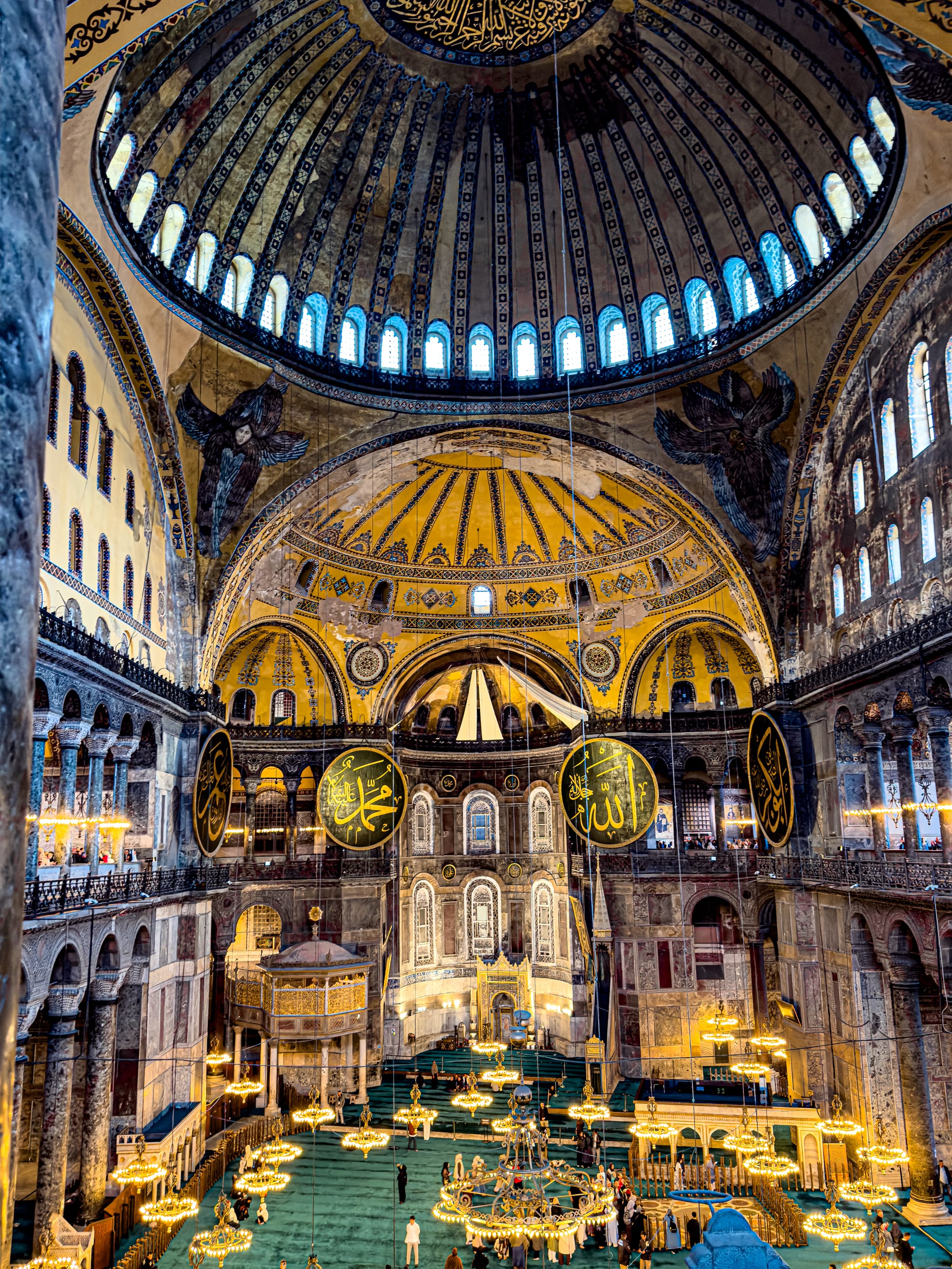
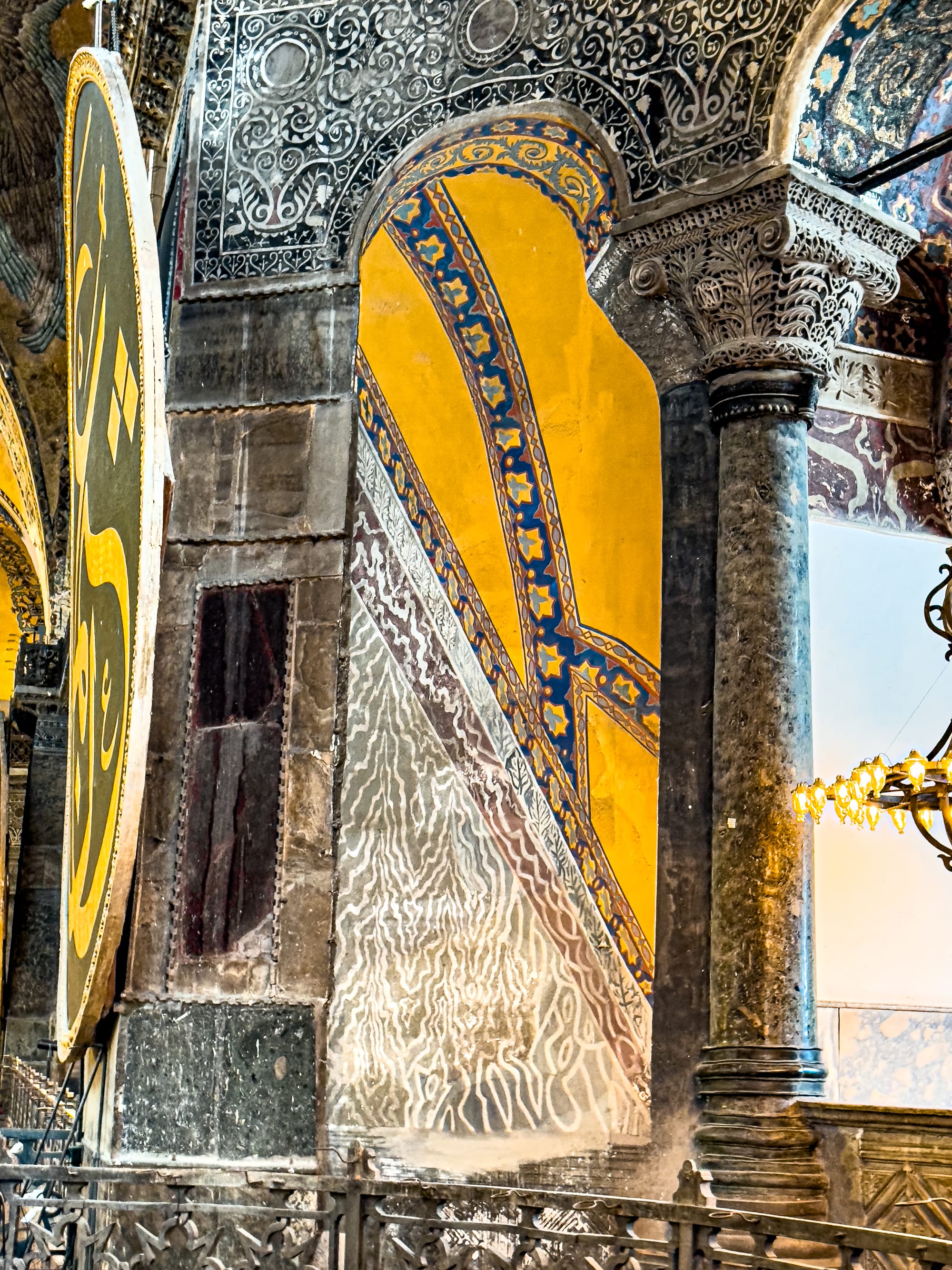
Every detail tells a story—from the golden tesserae of Christ Pantocrator peeking through centuries of plaster, to the grand mihrab pointing towards Mecca, set within what was once the altar. Light streams in through rows of windows, softening the massive space into something almost otherworldly. Whether you arrive for its architectural feats, its layered spiritual legacy, or simply the way it seems to hold the weight of history in its walls, Hagia Sophia has a gravity that stays with you long after you’ve stepped back into the bustle of Istanbul’s streets.
The Blue Mosque
An icon of Ottoman grace and symmetry.
Formally known as the Sultan Ahmed Mosque, the Blue Mosque is one of Istanbul’s most recognizable landmarks—and one of its most elegant. Completed in 1616 during the rule of Sultan Ahmed I, it was designed to rival the nearby Hagia Sophia, blending the grandeur of Byzantine architecture with the refined aesthetic of the Ottoman era. Its six slender minarets pierce the skyline, while a cascade of domes and semi-domes draws the eye upward. Step inside and you’ll see where it gets its nickname: over 20,000 hand-painted Iznik tiles in rich blues and greens cover the walls, each one a small masterpiece of floral and geometric patterns.
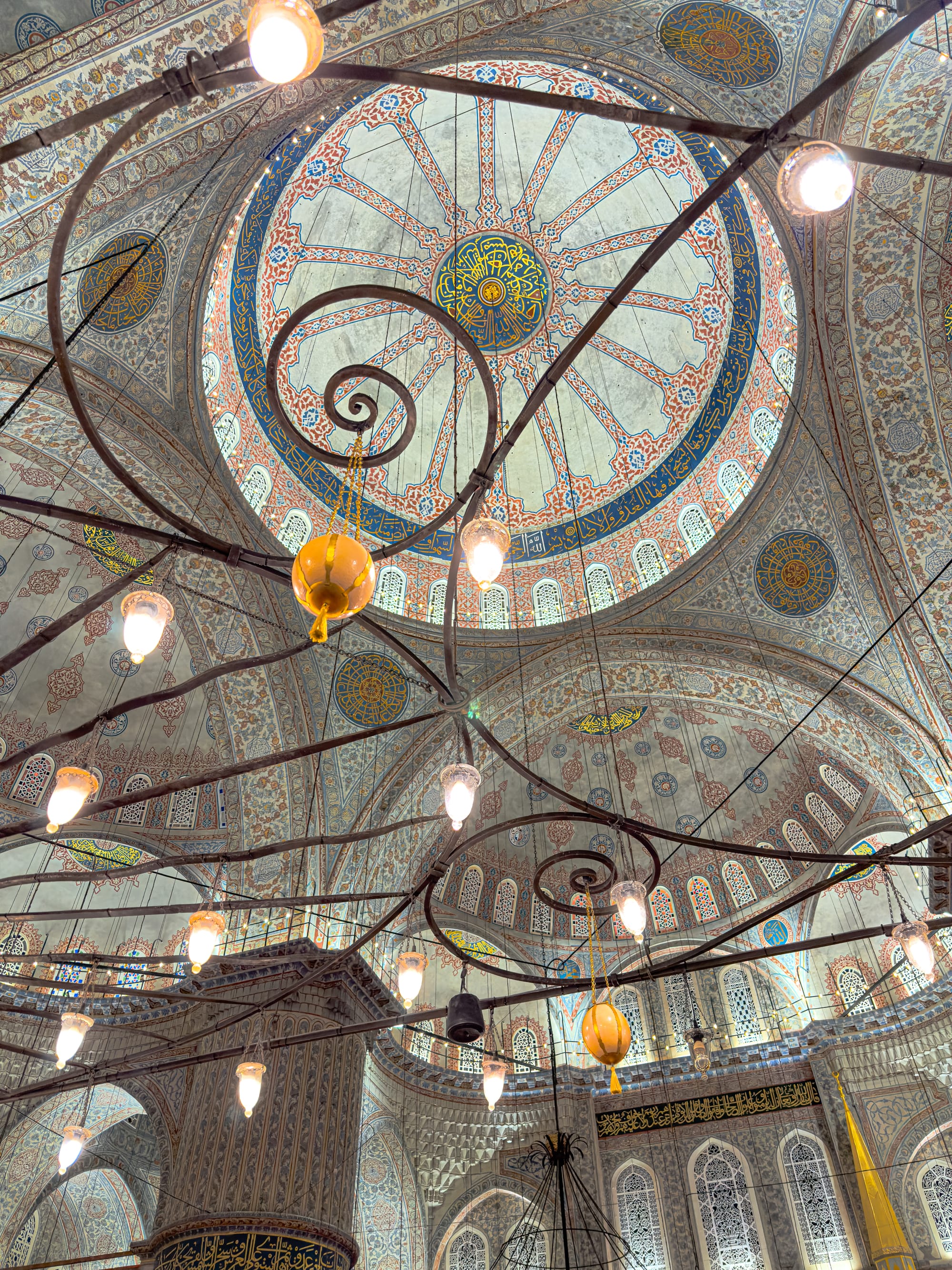
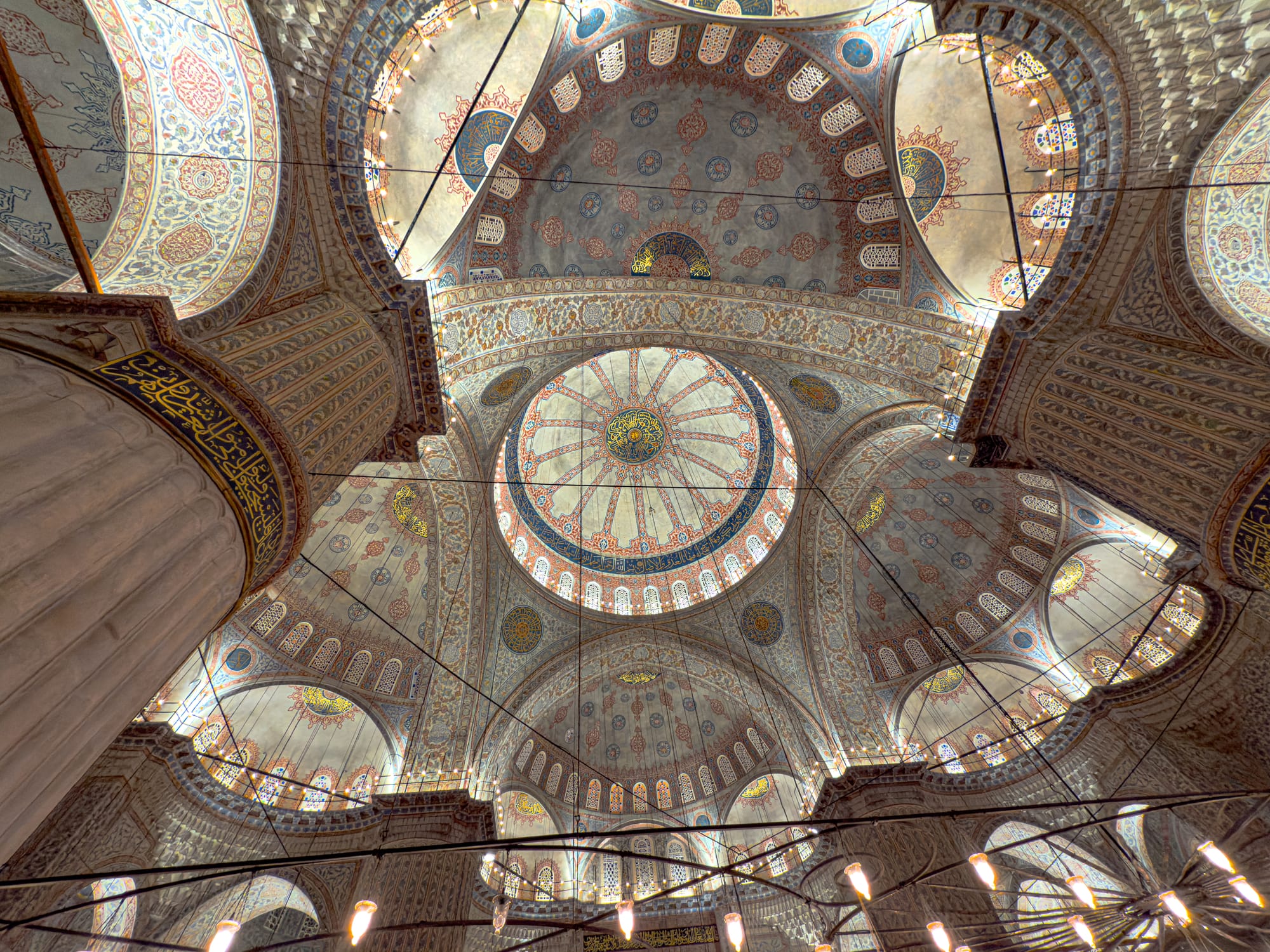
The interior feels both expansive and intricate. Sunlight streams through more than 200 stained-glass windows, casting soft colors over the carpeted floors, while calligraphic panels inscribed with verses from the Quran circle the central dome. Despite being one of the city’s most visited sites, it retains a serene, devotional atmosphere—especially if you come early in the morning or during quieter prayer times. As an active mosque, it’s not just a historical monument but a living place of worship, where past and present meet beneath a canopy of domes and light.
Bosphorus Cruise
Istanbul’s skyline from the water.
It's not a landmark it its own right, but a cruise along the Bosphorus will offer a glimpse of many. It's one of the most scenic ways to experience Istanbul, offering a shifting panorama of the city’s historic and modern faces. From the deck, you’ll see Ottoman palaces, waterfront mansions, minarets, and the graceful sweep of the Bosphorus bridges—all set against the ever-changing light of the strait. Many cruises run at sunset, when the skyline glows in gold and the call to prayer drifts over the water, adding another layer of atmosphere to the journey.
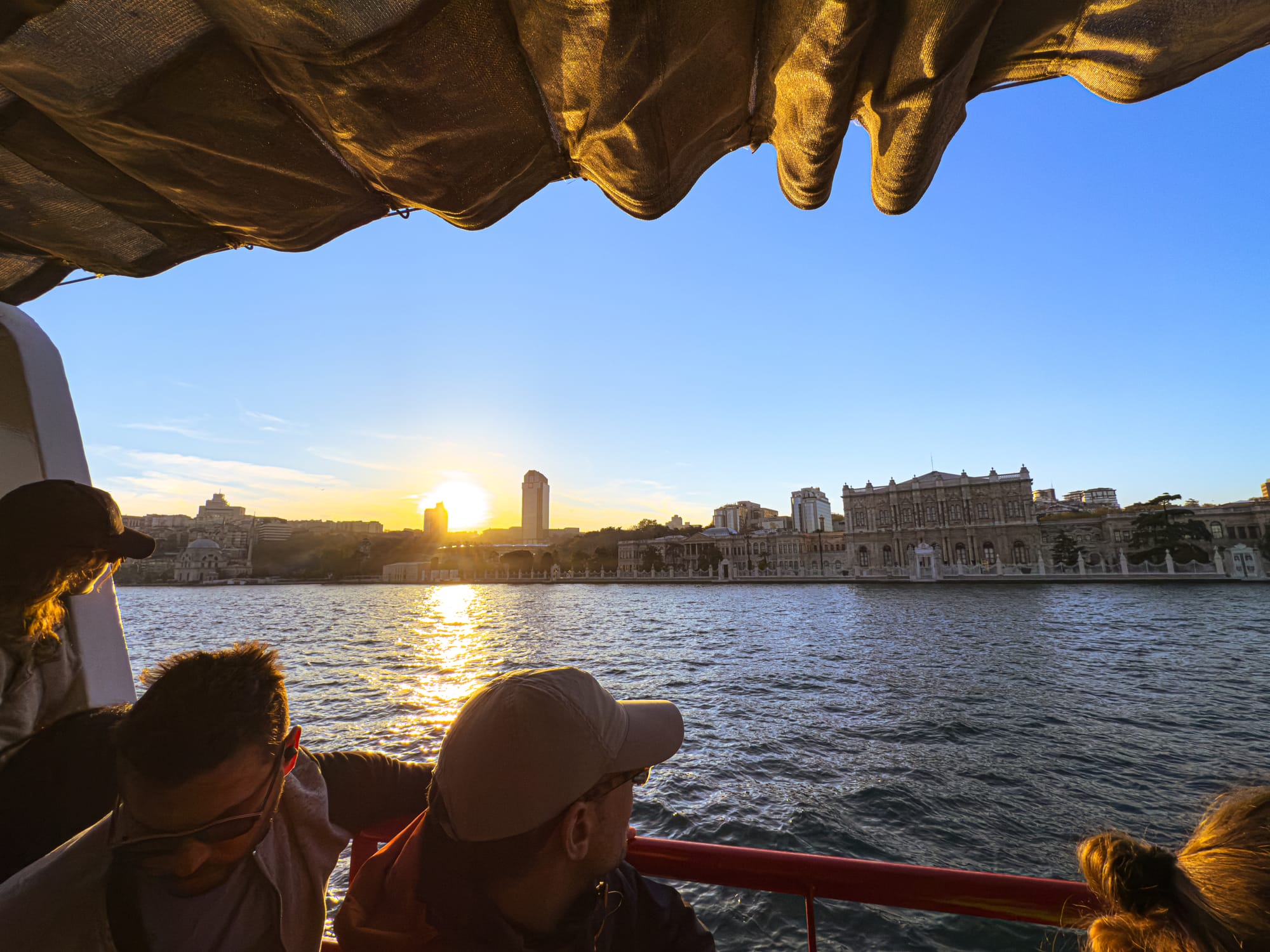
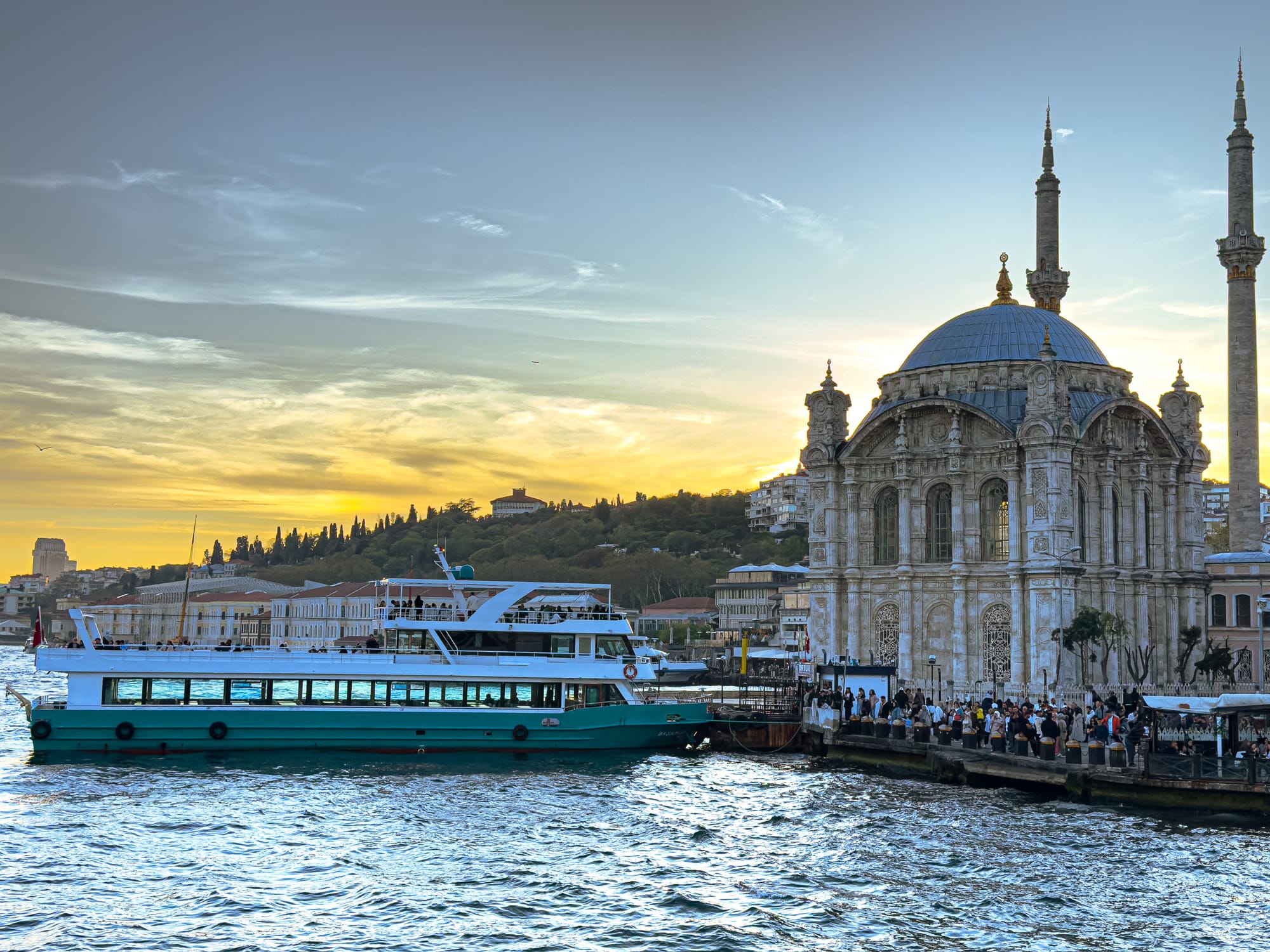
Beyond the landmarks, the cruise reveals the rhythm of the city’s relationship with the water—fishing boats heading out, ferries cutting across the current, seabirds tracing the wakes. Whether you choose a short loop or a longer trip that reaches the Black Sea, it’s an easy way to get a sense of Istanbul’s geography and grandeur in a single sweep. For those with limited time in the city, it’s a perfect orientation; for repeat visitors, it’s a ritual worth repeating.
Neighborhoods and local rhythms
Fener & Balat
Layers of history in technicolor.
Once home to Greek Orthodox, Armenian, and Jewish communities, the neighboring districts of Fener and Balat are some of Istanbul’s most storied—and most photogenic—areas. Cobbled streets wind past pastel-colored houses, ornate churches, and weathered synagogues, each corner holding a trace of the city’s layered past. St. George’s Cathedral, the seat of the Ecumenical Patriarchate, stands as one of the area’s most significant landmarks, while side streets reveal antique shops, family-run bakeries, and traditional tea houses.
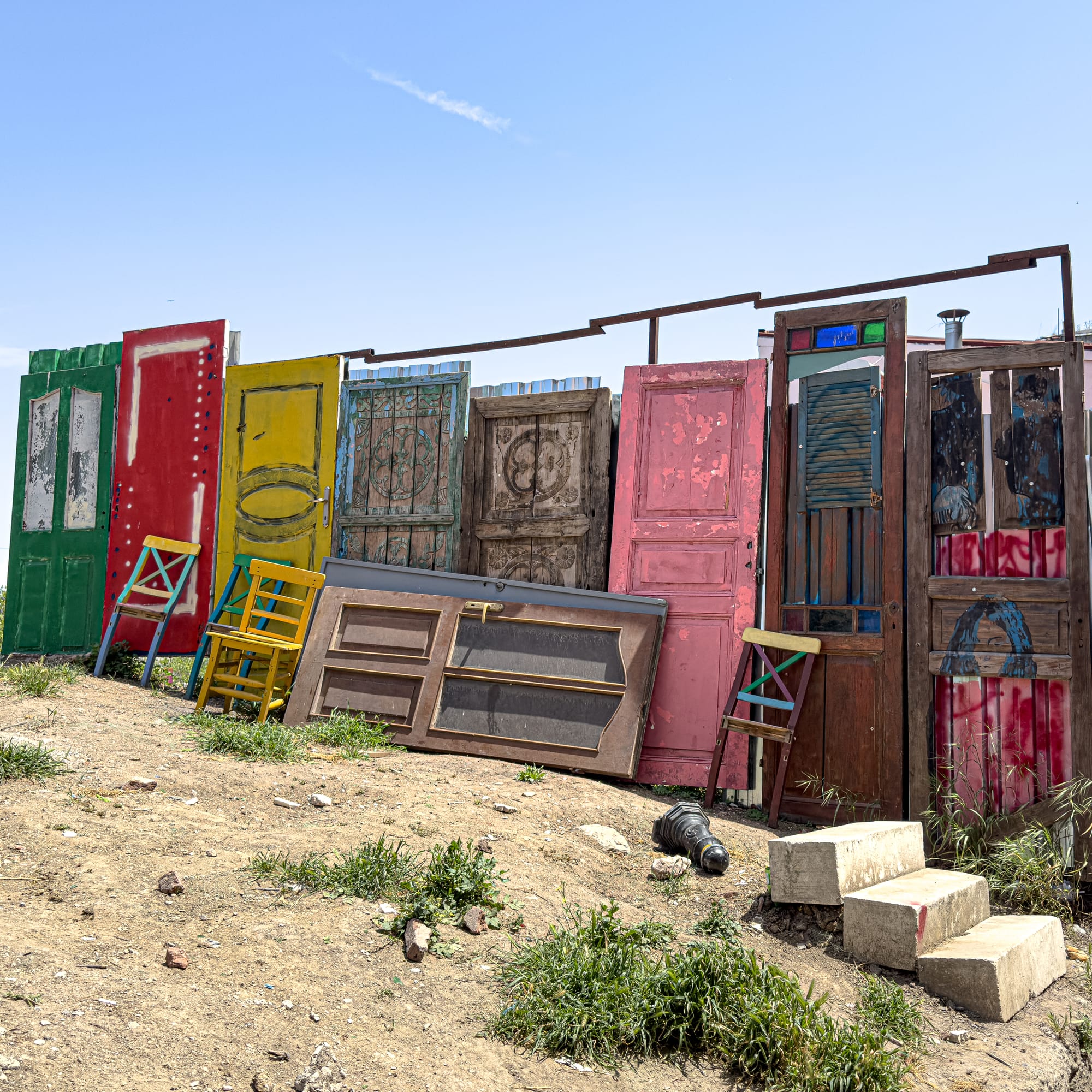
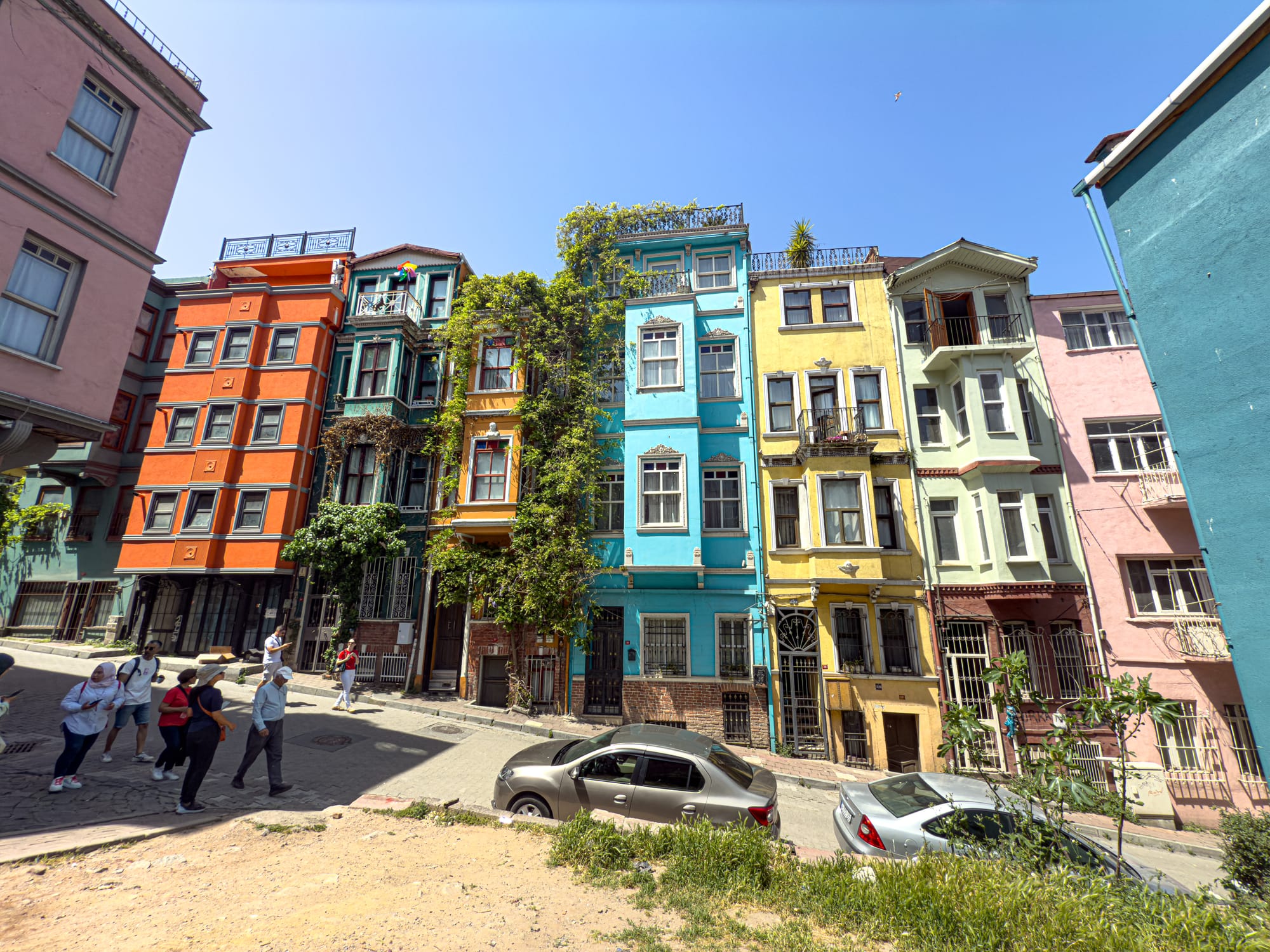
What makes Fener and Balat truly unforgettable, though, is their palette. Rows of brightly painted houses climb the hills, stairways splash with color, and shopfronts brim with vintage finds. The atmosphere is creative yet grounded, with locals chatting outside corner stores and cats sunning themselves on doorsteps. Whether you join a walking tour to learn about the area’s multicultural heritage or simply wander with your camera, it’s an area that rewards unhurried exploration.
Kadıköy
Istanbul’s creative, alternative heartbeat.
On the Asian side of Istanbul, Kadıköy blends a laid-back residential vibe with a distinctly youthful, artistic energy. Known for its colorful street art, bustling café culture, and thriving food scene, it’s a neighborhood where you can spend hours wandering without ticking off a single “must-see” attraction. Markets spill over with fresh produce, antique shops hide treasures in cluttered corners, and music drifts from open doorways. While it’s far from the tourist-heavy landmarks of Sultanahmet, Kadıköy offers something rarer—a glimpse of daily life in one of the city’s most creative hubs.
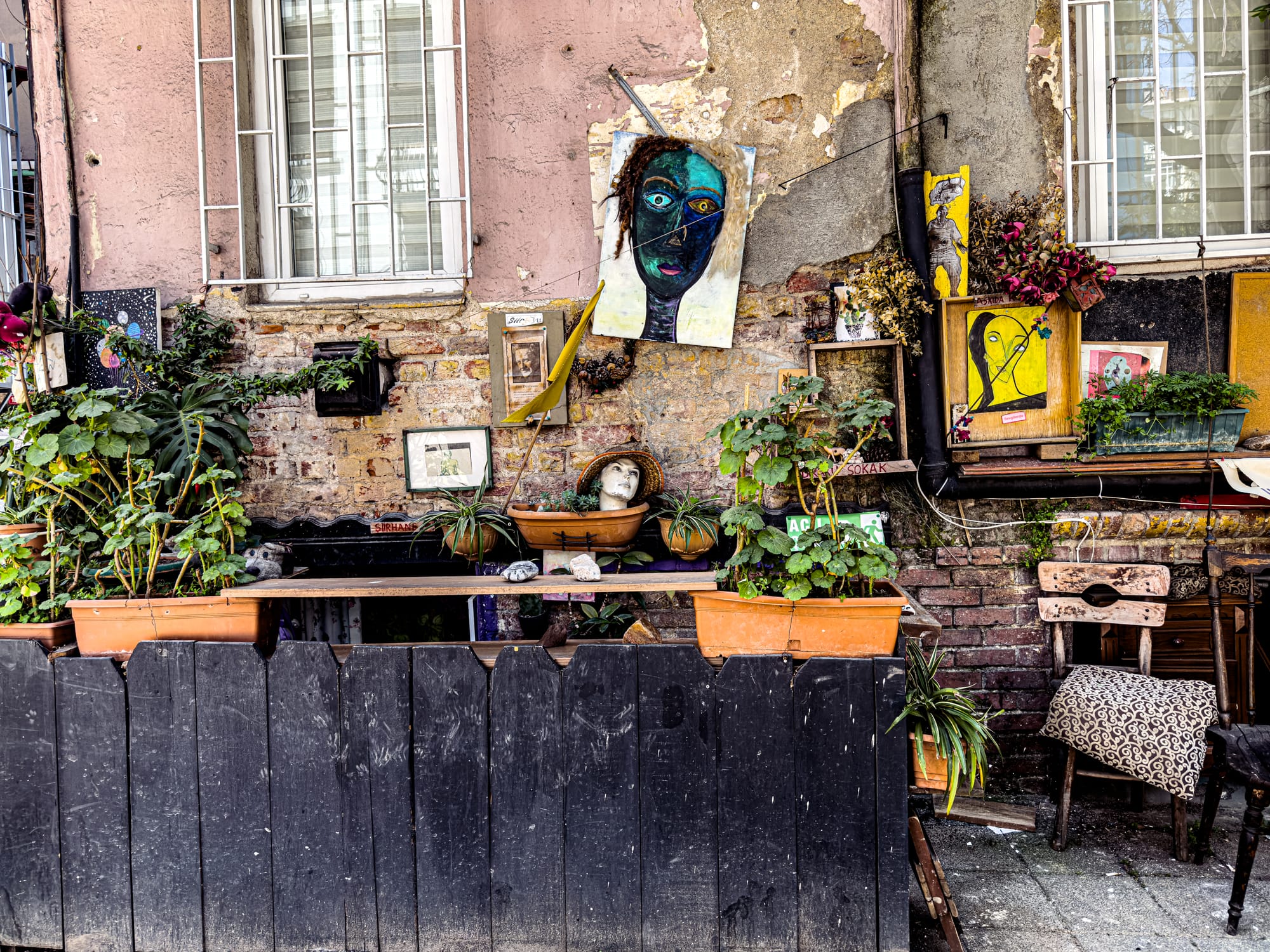
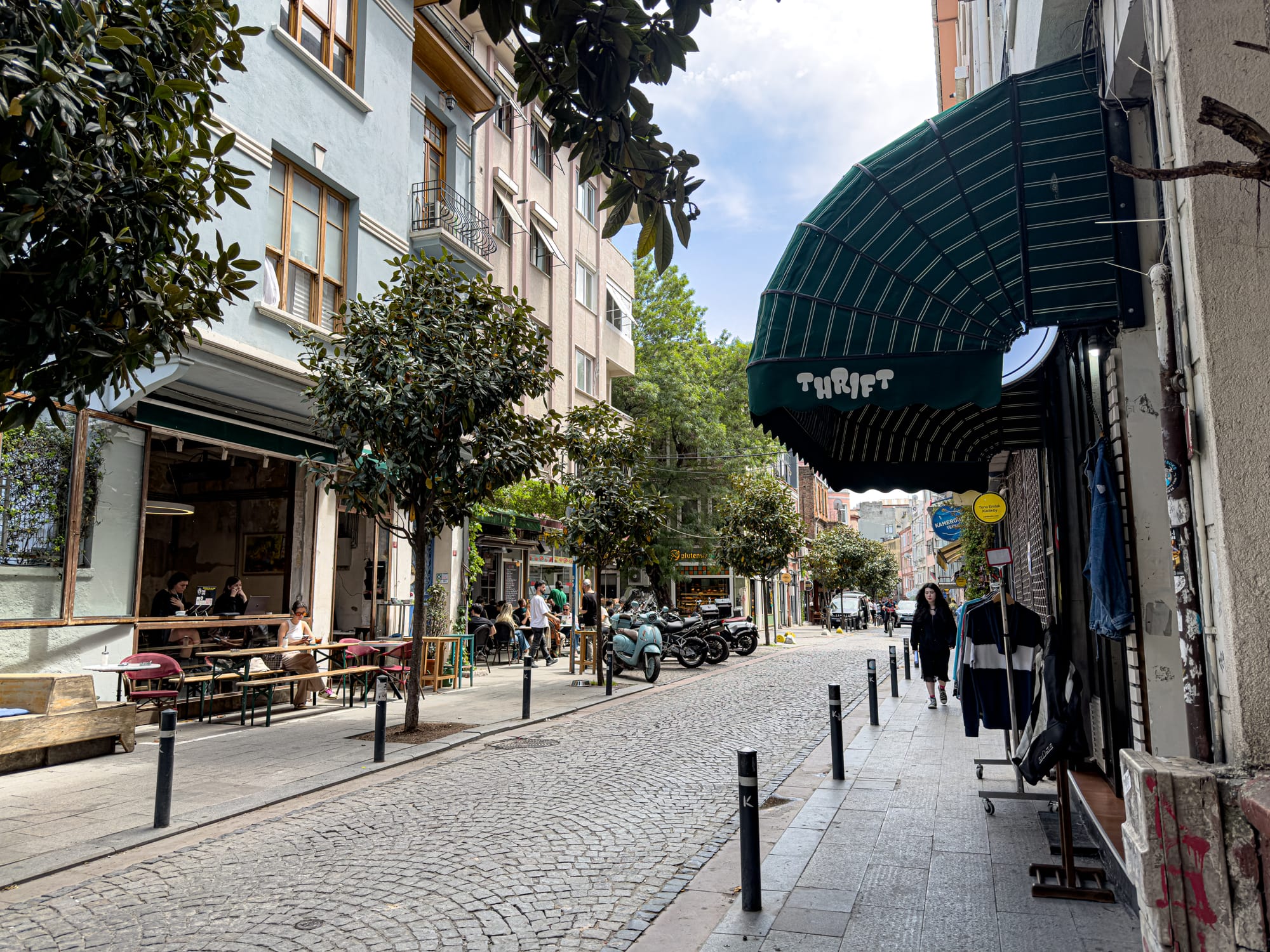
The Yeldeğirmeni sub-neighborhood, in particular, has become a canvas for international muralists, making it a must-visit for street art lovers. Vegan-friendly restaurants, independent boutiques, and cozy bookstores are scattered between leafy streets, and the waterfront promenade offers breezy views of the Bosphorus. For digital nomads, it’s not just a great place to explore—it’s a neighborhood worth basing yourself in, with its blend of local charm, alternative culture, and easy ferry access to Istanbul’s historic core.
Street art in Kadıköy
An open-air gallery with a rebellious streak.
Kadıköy’s Yeldeğirmeni neighborhood has become one of Istanbul’s most dynamic canvases, attracting world-class muralists from across the globe. Towering works by artists like INTI, Fintan Magee, and Dome rise above narrow streets, blending global street art styles with the area’s gritty, lived-in character. Some murals carry political messages or nods to local history, while others revel in pure visual impact—massive portraits, surreal scenes, and intricate patterns transforming entire facades.
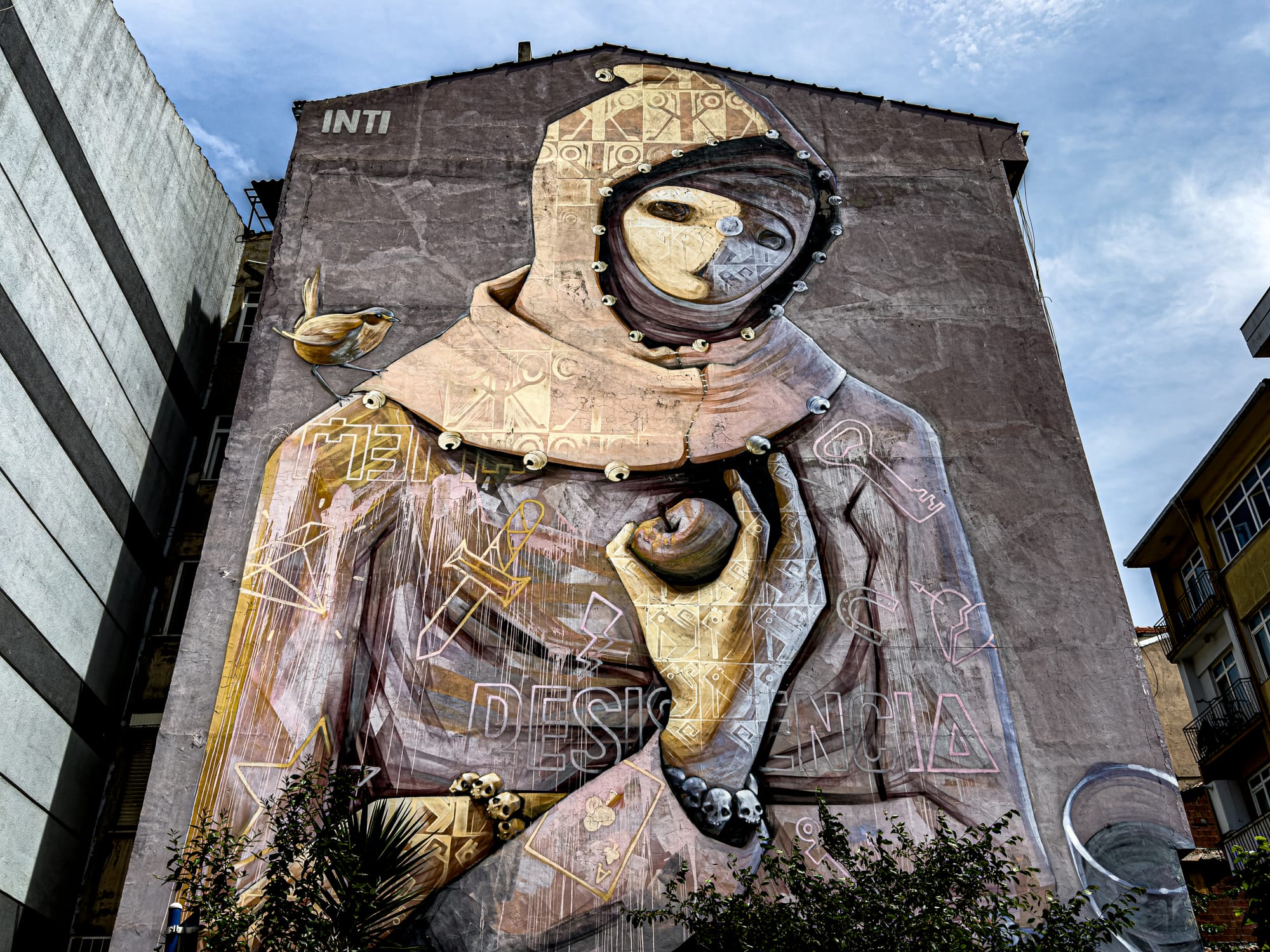
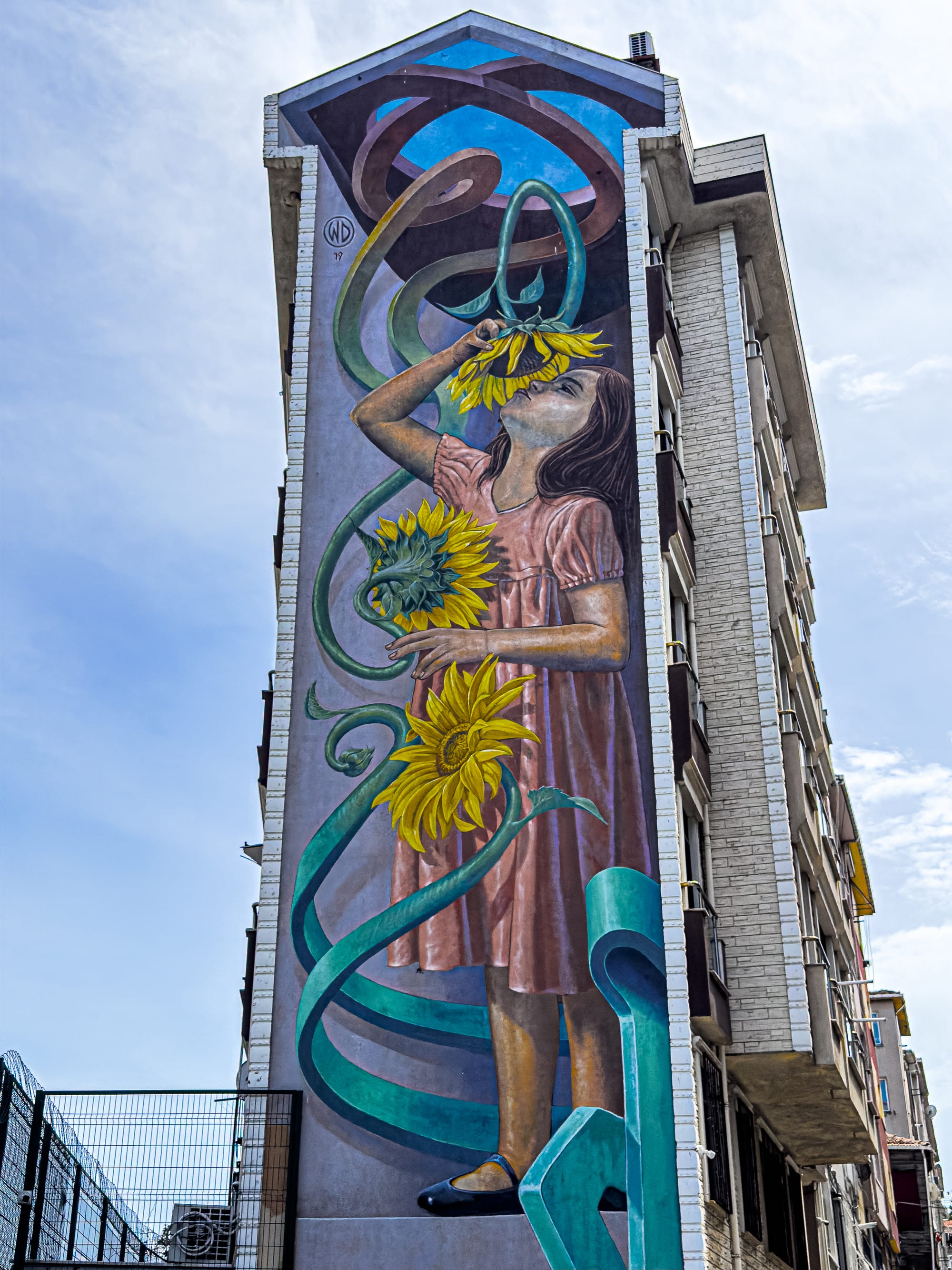
But street art here isn’t confined to walls. You’ll find it on shop shutters, utility boxes, and even staircases, creating an atmosphere where creativity feels embedded in everyday life. Exploring on foot—whether with the help of a Google Maps art guide or simply by wandering—offers a constant sense of discovery, as new works appear and older ones fade into the city’s texture. It’s a neighborhood that wears its artistic identity proudly, and invites you to look closer.
The Tuesday and Friday Bazaar
Kadıköy’s freshest flavors and best bargains.
Held twice a week, the Tuesday and Friday Bazaar in Kadıköy is a sensory overload in the best way. Long rows of stalls brim with seasonal produce—shiny aubergines, fragrant herbs, sun-warmed tomatoes, and, in summer, baskets of sweet mulberries. Prices are a fraction of what you’ll find at supermarkets, and vendors often encourage you to taste before you buy. For anyone cooking at home in Istanbul, this is the place to fill your kitchen with the city’s freshest ingredients.
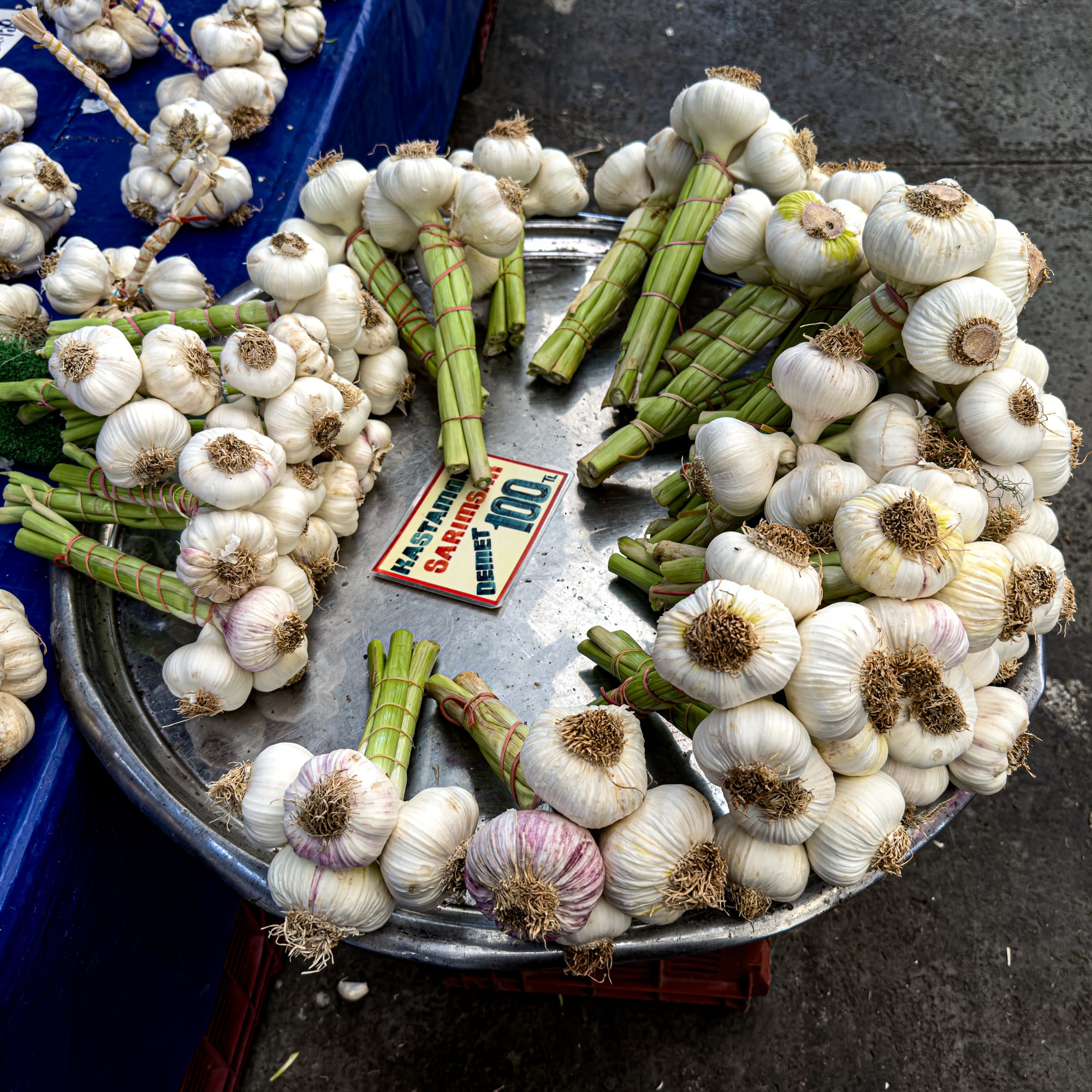
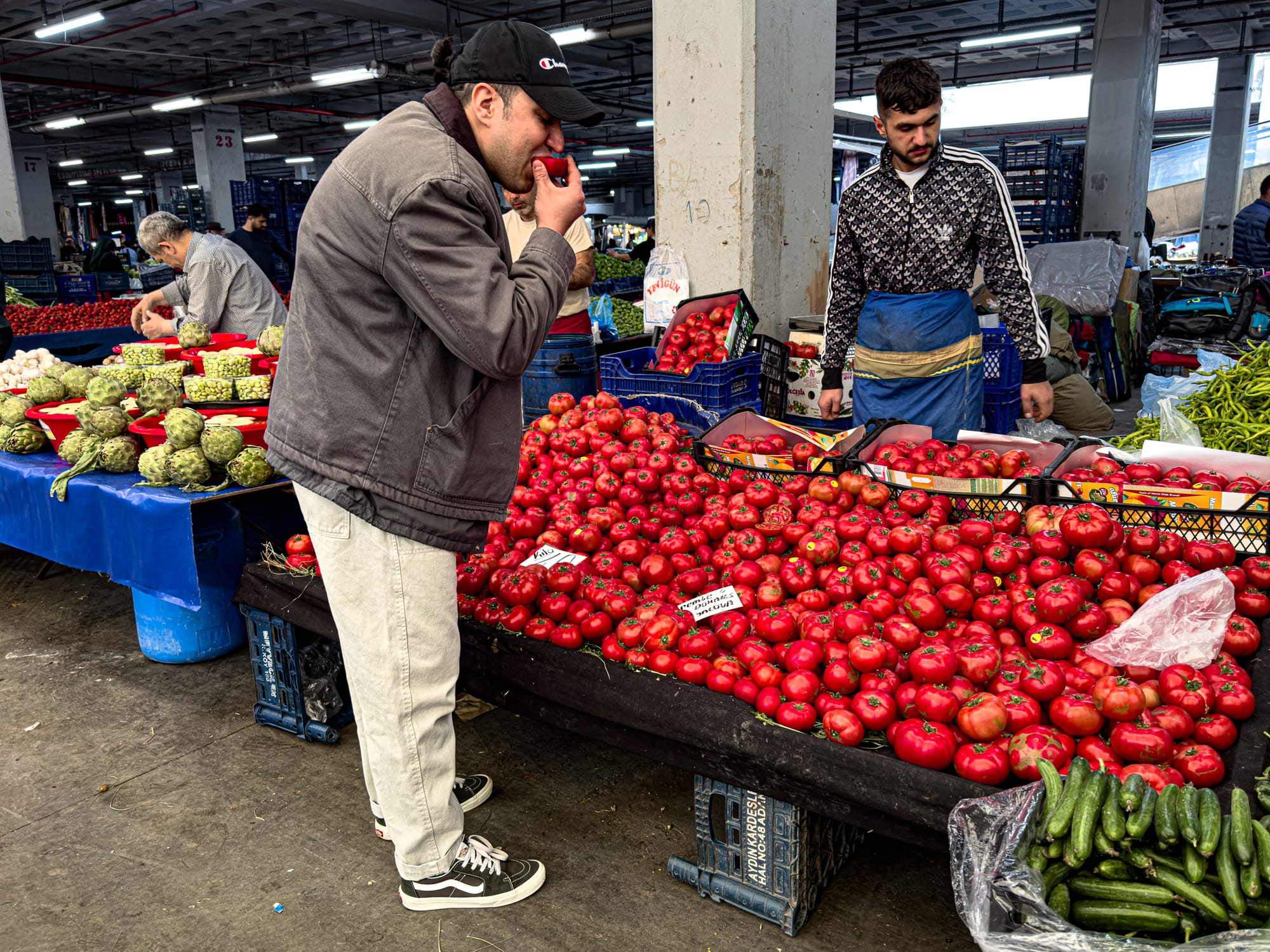
Beyond fruit and vegetables, the bazaar is a treasure trove for secondhand clothing, household goods, and random finds you didn’t know you needed. The atmosphere is lively but local, with shoppers ranging from lifelong residents to curious visitors stocking up for the week. Whether you’re after pantry staples, a new scarf, or simply an hour of people-watching, it’s a vibrant glimpse into Kadıköy’s everyday life.
Vegan food in Istanbul
Plant-based abundance in a city of rich flavors.
Istanbul has one of the most exciting vegan food scenes we’ve experienced, with options ranging from fully vegan restaurants to lokantas and street food spots serving plant-based Turkish staples. Kadıköy is especially vibrant, home to standouts like Veganarsist and the fully vegan market Vegan Dükkan Lokanta, but you’ll also find great options scattered across neighborhoods from Beyoğlu to Balat. Traditional dishes like mercimek çorbası (lentil soup), zeytinyağlı fasulye (beans in olive oil), and çiğ köfte are naturally vegan, offering a taste of Turkey’s culinary roots without compromise.
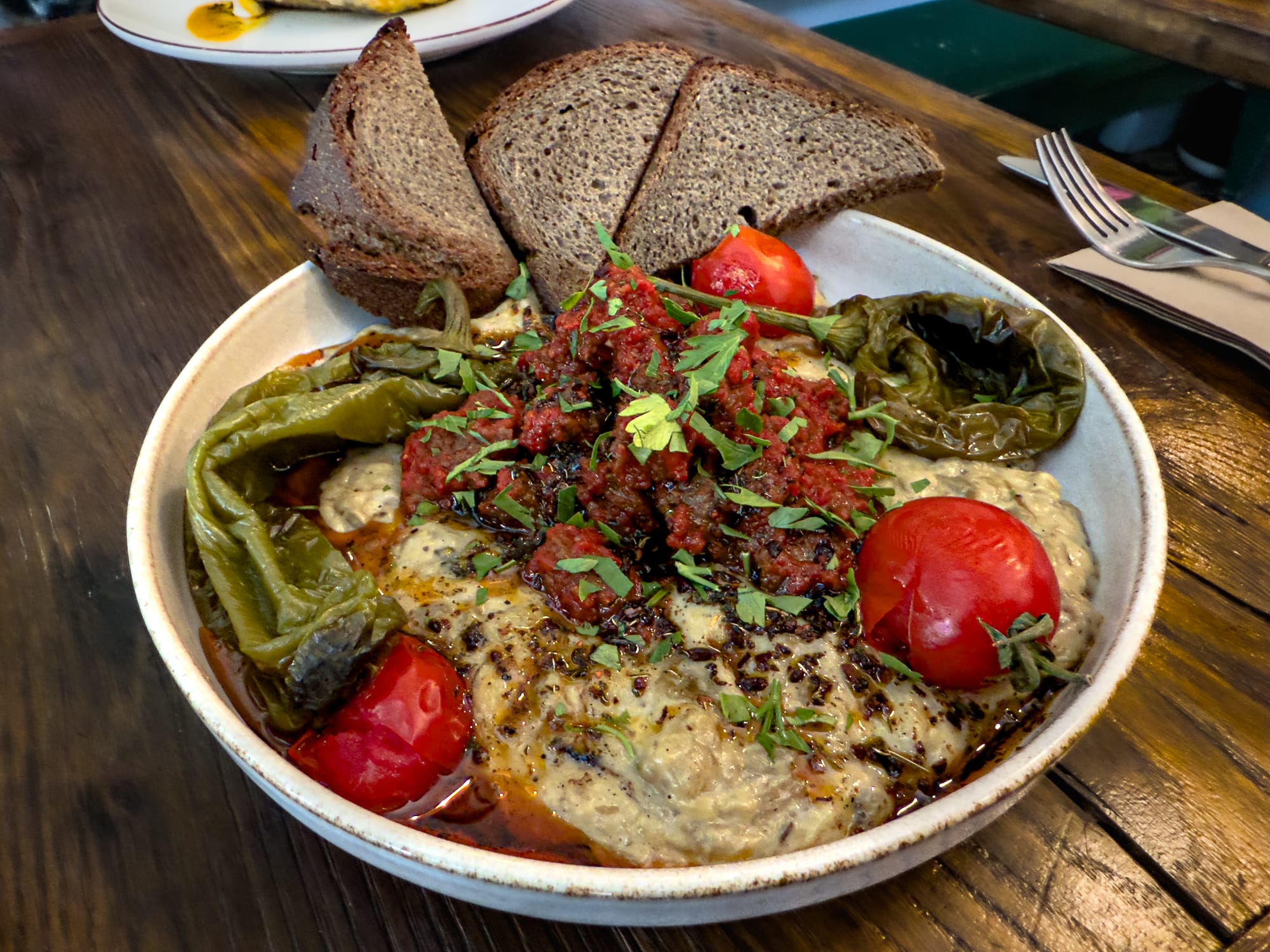
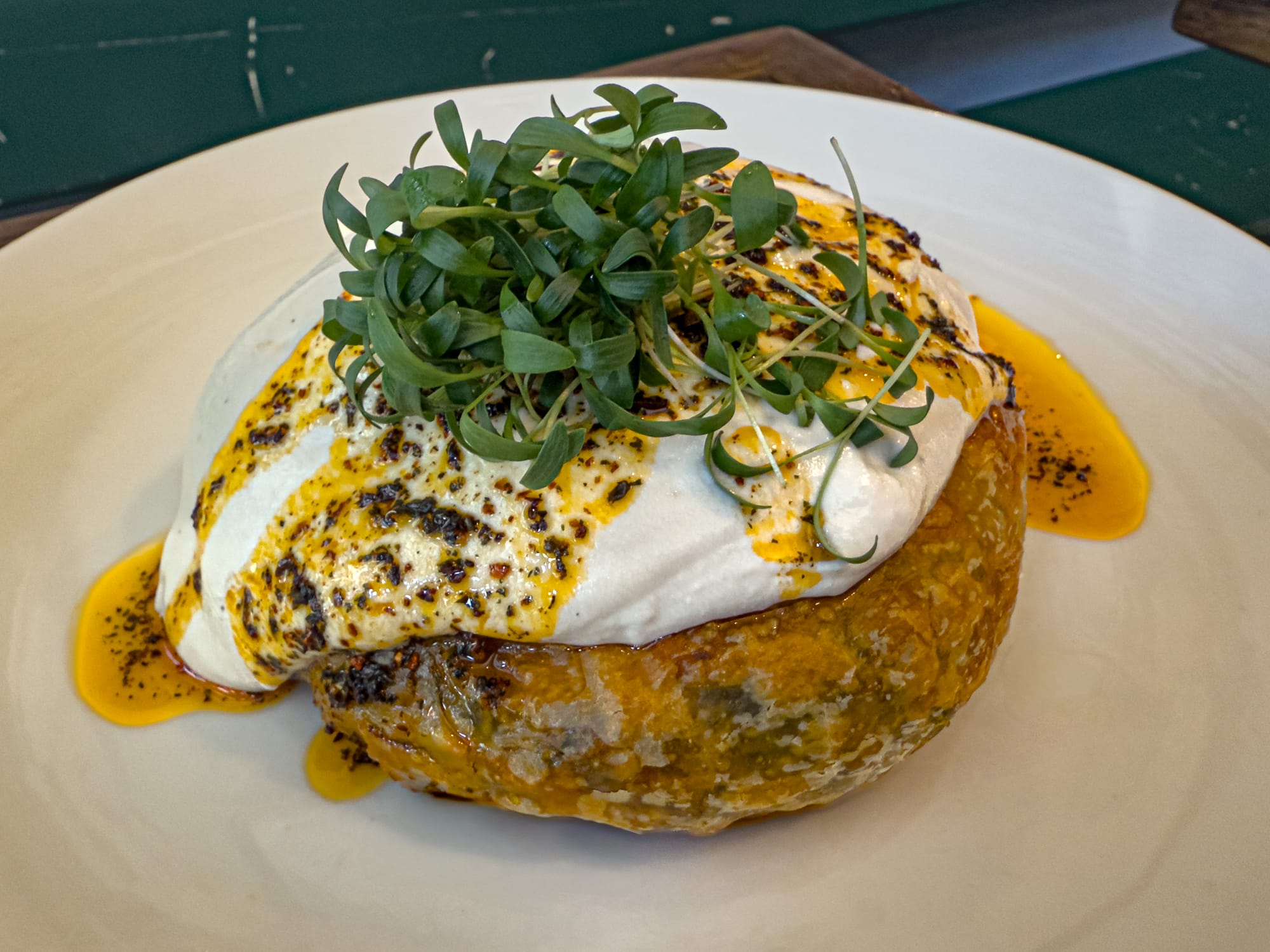
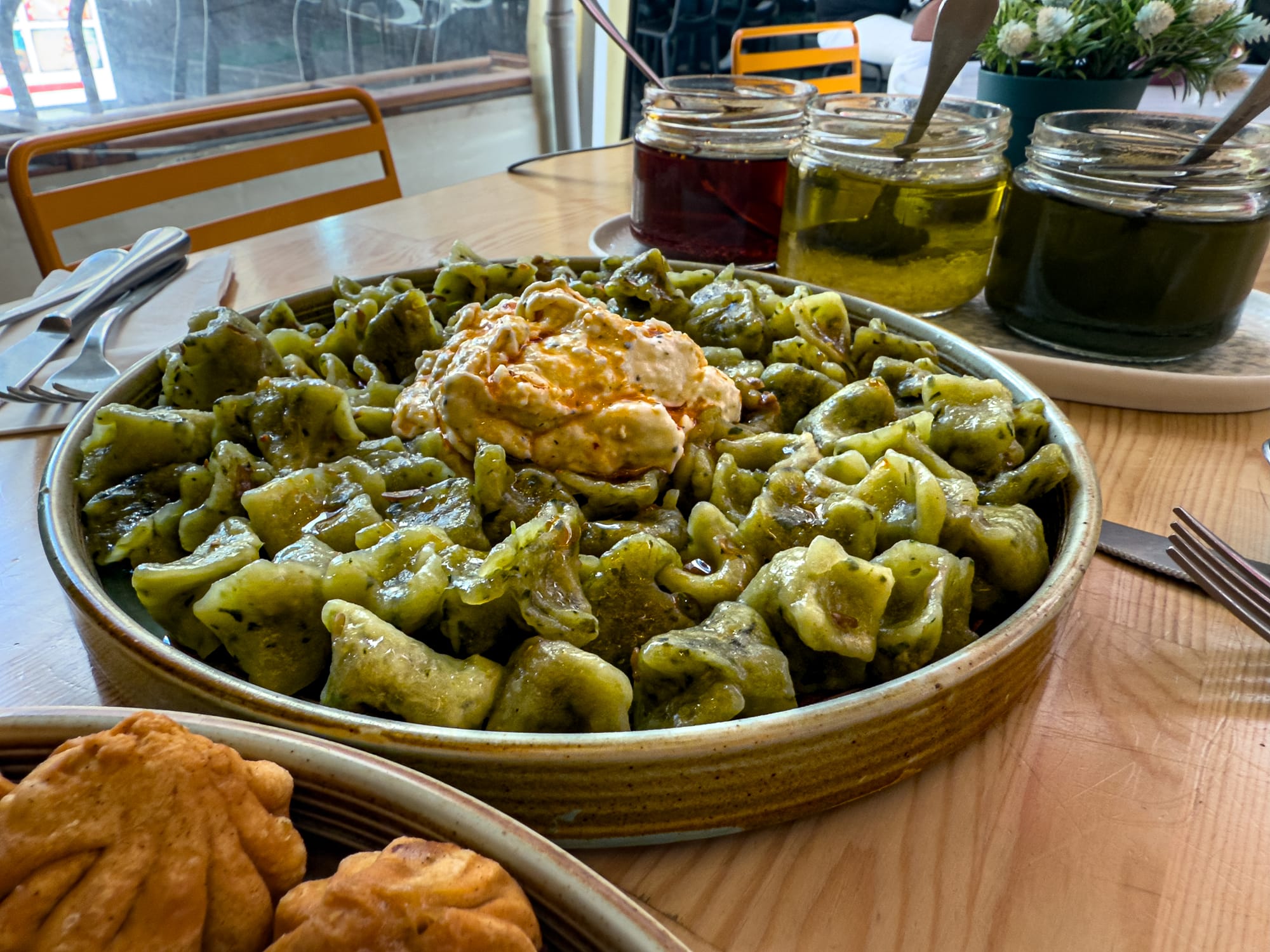
What makes the city so appealing for plant-based eaters is the variety—one day you might be tucking into smoky eggplant with vegan meatballs, the next enjoying pumpkin-stuffed momos or a cashew cheese börek. Between dedicated vegan spots, adaptable menus, and markets bursting with fresh produce, Istanbul makes it easy to eat well and creatively. Whether you’re here for a week or a few months, you’ll have no trouble keeping your meals exciting, flavorful, and rooted in local tradition.
Essential tools for Istanbul
For nomads living and working from Istanbul, these tools made our stay smoother.
Saily Global eSIM
Instant global mobile data without needing a local SIM. Saily global eSIM gives you mobile data in Turkey and dozens of other countries—no need to buy a separate local SIM when you arrive. Great for digital nomads who hop between places and want one seamless solution that works everywhere.
SafetyWing (global health & travel insurance)
An affordable, digital-nomad-friendly insurance plan that covers both travel hiccups and medical needs. We like that it runs month-to-month and can be started even if you’re already abroad. Helpful for peace of mind, especially on remote islands where care may require transfers or added costs.
NordVPN
A lightweight, fast VPN that lets you secure your connection on public wifi—especially important when working from colivings, cafes, or airports. It also lets you access content as if you were back home, which is helpful for banking, streaming, or logging into sensitive accounts.
Wise (multi-currency payments)
Our favorite banking solution for multi-currency payments and avoiding bad exchange rates. Wise lets you pay in Turkish lira locally and manage funds across dozens of currencies. We used it to split group dinners, pay for tours, and withdraw cash without the large fees traditional banks charge.
Should you choose Istanbul?
Istanbul is not a plug-and-play digital nomad hotspot in the Chiang Mai or Lisbon sense—but it is one of the world’s most layered and alive cities to work from. The scale can be overwhelming, and the community is more scattered than concentrated, yet few places offer such a collision of histories, cultures, and daily rhythms. Here, your lunch break might be a ferry ride between continents, and your post-work wander could take you from a centuries-old hammam to a rooftop bar with a Bosphorus view.
The pros?
- A rich cultural and historical landscape—museums, mosques, bazaars, and neighborhoods that feel worlds apart
- Endless food options, from street simit to fine dining (and plenty of good coffee)
- A dynamic café scene with many laptop-friendly spots for remote work
- Excellent global connectivity as a major air hub
- The ability to live in distinct “versions” of the city, depending on your chosen neighborhood
- Inspiring day-to-day variety—your surroundings never feel static
The trade-offs?
- The city is huge—getting across town can take time, and you’ll need to plan your days around traffic and transit
- The nomad scene is dispersed; without effort, it’s easy to feel anonymous
- Noise and bustle are constant—this is not a quiet destination
- Cost of living can vary widely depending on area and lifestyle
If you thrive in calm, controlled environments, Istanbul might feel like too much. But if you draw energy from movement, from complexity, from a place where history is on every corner and no two days feel the same, this city offers a backdrop unlike anywhere else.
Read more
If you’re curious about how to make Istanbul work for you, we’ve written extensively about our experience. Check out our Istanbul guides for more information on what we enjoyed in the city.






